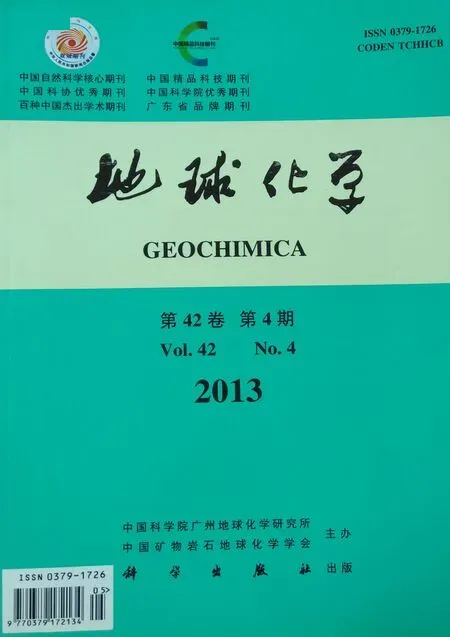大别山北麓早白垩世商城和达权店岩体的地球化学特征与成因
高昕宇, 赵太平, 施小斌, 张忠慧, 包志伟
(1. 中国科学院 南海海洋研究所 边缘海地质重点实验室, 广东 广州 510301; 2. 中国科学院 广州地球化学研究所矿物学与成矿学重点实验室, 广东 广州 510640; 3. 河南省 山水地质旅游公司,河南 郑州 450001)
0 引 言
秦岭-大别造山带位于中国中部, 是一个经历了多阶段构造演化的复杂的大陆碰撞造山带[1–2], 历经中元古代-古生代的多次陆缘裂解、增生和碰撞,三叠纪华北与扬子大陆板块之间的对接, 三叠纪-侏罗纪的地壳缩短(拆离、推覆、A型俯冲), 东段大别造山带的超高压变质作用[3–6], 以及随后的强烈伸展塌陷和岩石圈拆离[7–10]。
秦岭-大别造山带演化后期广泛发育花岗质岩浆作用, 根据前人的研究成果, 东秦岭-大别地区中生代岩浆岩的形成时代主要集中于 145~110 Ma之间[11–20]。大别造山带中生代岩浆活动特别强烈, 是世界上超高压变质地体中碰撞后花岗质岩浆活动最为强烈的地区[21], 大规模的晚中生代花岗岩类出露面积约占区域面积的 17%[22]。在 145~130 Ma形成的花岗岩体, 常具有高 Sr、Ba、La/Yb, 低 Y、Yb的地球化学性质, 被称为“埃达克质岩”; 在130~110 Ma形成的普通花岗岩, 具有明显亏损 Ba、Sr、Eu的地球化学特征[11,19,23,24]; 而且, 在130~123 Ma, 基性侵入体也比较发育[25–31]。这两个阶段的花岗岩可能分别形成于碰撞和地壳加厚之后的伸展隆升阶段,代表了不同的深部地壳大陆动力学过程。不同阶段花岗岩类的岩石地球化学和同位素地球化学特征很可能记录了不同的热源和物源对花岗岩浆作用的贡献, 进而能制约造山带的演化历程。
商城和达权店花岗岩位于秦岭-大别造山带东段的北大别构造单元和北淮阳构造单元的结合部位,两个岩体相邻产出, 且在形成时代上分别介于上述145~130 Ma和130~110 Ma两个不同的花岗岩形成阶段1),[32,33], 但迄今对它们的研究程度较低, 其成因类型、源区特征及构造环境尚不明确, 对它们进行系统的地质-地球化学研究将有助于深入探讨秦岭-大别造山带中生代构造-岩浆演化过程及其动力学机制。本文拟通过系统的锆石 U-Pb同位素年代学、锆石Lu-Hf同位素以及主、微量地球化学研究对这一问题进行探讨。
1 地质背景
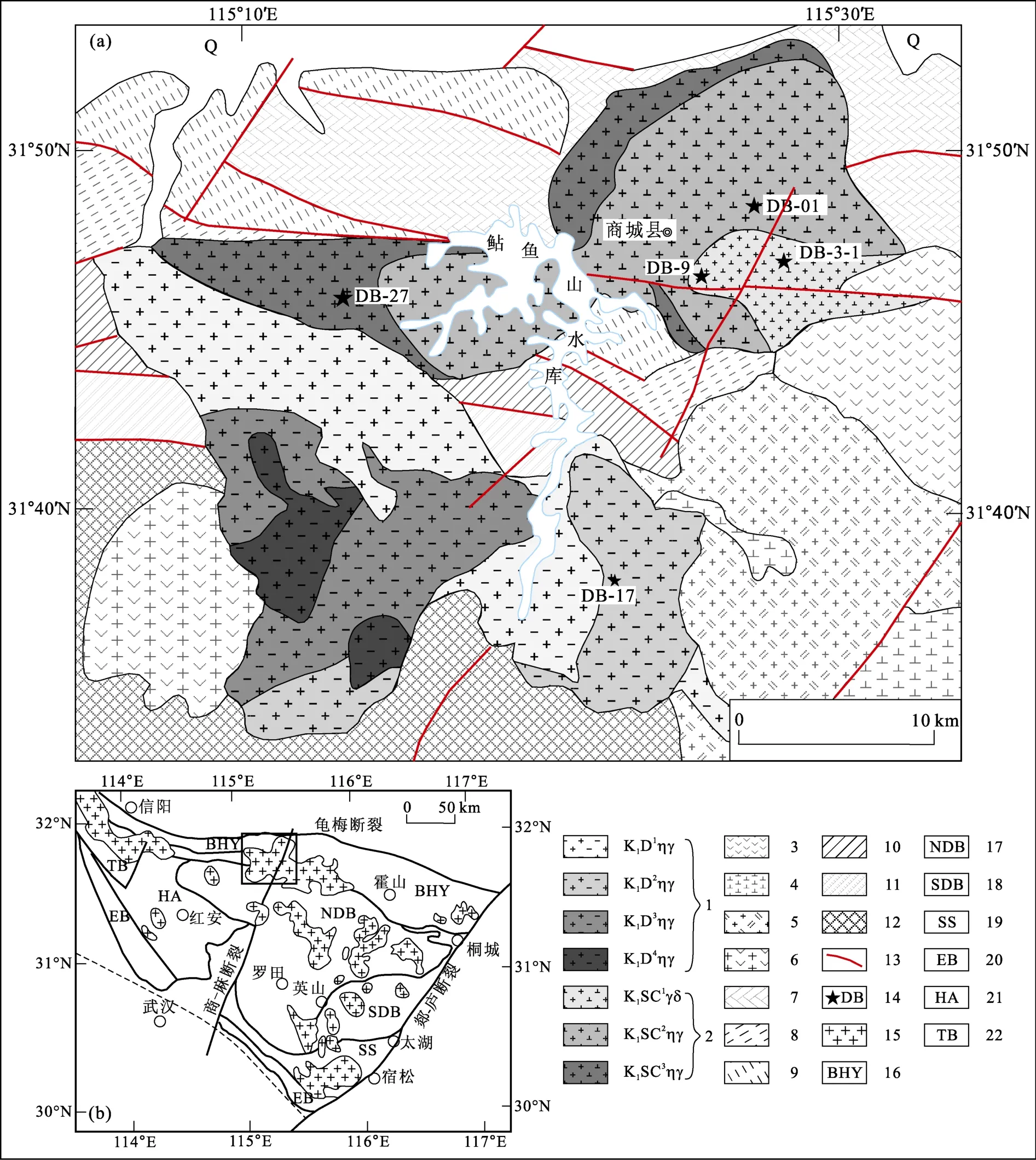
图1 河南商城和达权店花岗岩体地质图(据文献[34]、河南省地矿局第三地质调查队1) 河南地矿厅区域地质调查队, 1∶5万商城县幅、达权店幅中华人民共和国区域地质调查报告, 1992。 河南省地矿局第三地质调查队, 1∶25万河南省南部地质图, 2007。)Fig.1 Geological map of the Shangcheng and Daquandian granites (after [34] and the Third Geological Survey Team, Henan Provincial Bureau of Geo-Exploration and Mineral Development1) 河南地矿厅区域地质调查队, 1∶5万商城县幅、达权店幅中华人民共和国区域地质调查报告, 1992。 河南省地矿局第三地质调查队, 1∶25万河南省南部地质图, 2007。)
商城和达权店岩体位于秦岭-大别造山带东延的北大别隆起带和北淮阳褶皱带的结合部位, 属大别造山带范畴(图1)。商城岩体出露面积约131 km2[32],主要为似斑状黑云母二长花岗岩, 侵位于下奥陶统龟山岩组、泥盆纪南湾岩组、石炭系杨小庄组和胡油坊组中, 被后期形成的下白垩统金刚台组火山岩覆盖。达权店岩体位于商城岩体南部, 出露面积141 km21)河南地矿厅区域地质调查队, 1∶5万商城县幅、达权店幅中华人民共和国区域地质调查报告, 1992。, 主要为二长花岗岩, 区域上侵入下元古界大别杂岩, 中元古界浒湾岩组, 震旦系-下奥陶统肖家庙岩组及早白垩世朴店花岗岩。区域地层岩石普遍经受过中-深区域变质作用, 变质作用达角闪岩相。区域构造以推覆构造和断裂构造为主, 主要有东西向的桐柏-商城断裂和近南北向的商城-麻城断裂(图1)。区域岩浆岩以早白垩世中晚期的中酸性侵入岩为主, 商城和达权店岩体均为该区域较大的侵入岩体, 岩体中偶见少量后期侵入的基性岩墙。
2 岩石学特征
商城花岗岩体由 3期侵入体组成, 第 1期侵入体位于岩体东南部, 呈不规则椭圆形, 面积约 34 km2, 岩性为巨斑状粗粒黑云母二长花岗岩(图 2a),似斑状结构, 斑晶由钾长石组成, 含量 10%~20%,基质为粗中粒花岗结构, 块状构造; 第 2期侵入体位于岩体中部, 面积约 71 km2, 岩性为似斑状中粒黑云母二长花岗岩, 似斑状结构, 斑晶由钾长石组成, 含量为5%~15%, 基质为中粒花岗结构, 块状构造; 第3期侵入体位于岩体外围, 呈环状分布, 面积约26 km2, 岩性为似斑状细中粒黑云母花岗闪长岩,似斑状结构, 钾长石斑晶含量为 5%~8%, 具卡斯巴双晶(图2e), 分布均匀, 基质具中细粒花岗结构, 块状构造。3个期次侵入体的基质均由斜长石(33%~60%)、钾长石(10%~30%)、石英(20%~30%)和黑云母(1%~5%)组成(图2c), 有少量角闪石。斜长石均为奥长石, 多为半自形-他形粒状, 具有聚片双晶及环带结构(图 2d); 钾长石多为他形; 石英为他形粒状, 波状消光; 黑云母为半自形片状-鳞片状;副矿物主要为磁铁矿、榍石、磷灰石和锆石。含有不同程度的富云包体和暗色微粒包体, 富云包体主要由黑云母和斜长石组成, 暗色微粒包体主要由斜长石、角闪石、辉石和黑云母组成。
达权店花岗岩体位于商城花岗岩体的南部, 分布面积达141 km2, 由4个期次侵入体组成: 第1期侵入体分布于达权店岩体的北部和东南部, 分布面积约为76 km2, 岩性为似斑状-含斑二长花岗岩, 似斑状结构, 斑晶为钾长石、条纹长石, 基质为花岗结构, 局部有交代残留、净边、蠕虫结构, 块状构造;第 2期侵入体分布于岩体的南部和东南部, 分布面积约为 29 km2, 岩性为中粒二长花岗岩(图 2b), 中粒花岗结构, 局部交代残留结构, 块状构造; 第3期侵入体分布于岩体的中部, 分布面积约为 23 km2,岩性为中粒-细粒二长花岗岩, 中细粒花岗结构, 局部有交代结构, 块状构造; 第4期侵入体分布于第3期侵入体内部, 呈岩株产出, 分布面积约为13 km2,岩性为细粒二长花岗岩, 细粒花岗结构, 块状构造。4期侵入体新鲜岩石多为浅肉红色, 主要矿物为由钾长石、斜长石、石英和少量黑云母组成, 含少量角闪石。钾长石多为自形-半自形, 具有卡斯巴双晶(图 2g); 斜长石均为奥长石, 多为自形-半自形, 具有聚片双晶, 部分斜长石聚片双晶具环带状现象;石英多呈他形粒状, 蠕虫结构, 位于钾长石和斜长石的周围(图 2h); 黑云母多为半自形。副矿物主要为磁铁矿、榍石、磷灰石及少量褐帘石和锆石等。
3 样品与分析方法
本次工作的样品全部取自采石场或公路两侧的新鲜样品, 样品采集点散布在整个区域。选取 4个商城岩体样品(DB-1、DB-3-1、DB-9、DB-27)和 1个达权店岩体样品(DB-17)进行 LA-ICP-MS 锆石U-Pb 年龄和Lu-Hf同位素分析。挑选出的锆石粘于树脂中制成样品靶, 用于锆石 LA-ICP-MS锆石U-Pb同位素定年及原位 Hf同位素分析。锆石环带及内核信息通过锆石的阴极射线发光(CL)图来观察。10个商城岩体样品和8个达权店岩体样品磨成200目以下粉末用于主、微量地球化学分析。

图2 河南商城和达权店花岗岩体样品照片和显微照片Fig.2 Macro- and micro-photographs of Shangcheng and Daquandian granites
主元素和微量元素分析在中国科学院广州地球化学研究所完成。主元素用X射线荧光光谱法(XRF)测试。分析仪器为Rigaku 100e, 分析精度优于2%。微量元素用电感耦合等离子体质谱仪进行测试, 分析仪器为美国 Perkin Elmer公司产的 Elan6000 ICP-MS, 分析精度可达 5%。在质谱分析过程中用Rh元素作为内标来进行内部校正, 纯的元素标样作为外部校正, 实验室标样BHVO-1和SY-4作为参考标准。分析流程见文献[35]。锆石的CL图像拍照和LA-ICP-MS锆石U-Pb定年均在西北大学大陆动力学国家重点实验室完成。锆石的CL图像拍照采用FEI公司的XL30型SFEG电子束进行锆石内部结构显微照相分析。LA-ICP-MS锆石 U-Pb定年测试使用的 ICP-MS为 Agiligent 7500。锆石原位Lu-Hf同位素测定用Nu Plasma HR(Wrexham, UK)多接受电感耦合等离子体质谱仪完成(MC-ICP-MS)。用德国MicroLas公司生产的 193 nm ArF准分子(excimer)激光器的剥蚀系统, 激光剥蚀以氦气作为剥蚀物质的载气, 斑束直径为 44 μm,频率为10 Hz, 激光能量为90 mJ, 每个分析点的气体背影采集时间为 30 s, 信号采集时间为 40 s。LA-ICP-MS激光剥蚀为单点剥蚀采样方式。详细的分析步骤、仪器性能、工作参数及测试条件见文献[36–37]。使用国际标准锆石 91500[38]作为外标, 每测试4~5个点插入1次标样测定。同位素比值和含量计算及校正使用GLITTER 4.0 软件完成, 年龄计算以标准锆石91500为外标进行同位素比值分馏校正; 元素浓度采用NIST610作外标, Si作内标。普通铅矫正流程按照文献[39]方法处理。本次实验测定过程中, 91500锆石的176Hf/177Hf的测定结果是0.282308±34, 该值与用溶液法获得的值(0.282306±28[40])在误差范围内一致。U-Pb谐和线图和加权平均年龄的计算及绘图用Isoplot 3.0软件[41]完成, 处理结果见表1。
4 分析结果
4.1 锆石CL图像及U-Pb 同位素年代学
样品岩性分别为似斑状中粒黑云母二长花岗岩DB-1(地理坐标 31°49′20″N, 115°27′18″E)、巨斑中粗粒 二 长 花 岗 岩 DB-3-1(地 理 坐 标 31°47′18″N,115°27′54″E)、花岗斑岩 DB-9(地理坐标 31°45′53″N,115°25′26″E)、细粒黑云母二长花岗岩 DB-27(地理坐标 31°45′52″N, 115°13′04″E)和中粒二长花岗岩DB-17(地理坐标 31°40′19″N, 115°21′43″E)。锆石 CL图像(图3)显示, 商城和达权店岩体中的锆石大部分都具有继承锆石内核。锆石颜色从无色透明到浅黄色, 锆石呈长柱状或短柱状, 多数呈半自形-自形,粒径在 50~250 μm, 长宽比约为 2∶1~3∶1, 新生锆石边和新生锆石有岩浆韵律环带, 岩浆期锆石高的Th/U比值(0.41~2.86), 具有典型的岩浆锆石特征。
表1中列出了所有测点的锆石U-Pb同位素数据,除继承锆石或锆石中继承核的U-Pb年龄外, 较新的岩浆期锆石U-Pb年龄均集中于早白垩世。DB-1样品取自商城岩体第 2期侵入体, 24颗锆石的206Pb/238U表观年龄为133~2587 Ma(表1), 其中9颗锆石年龄集中于133~145 Ma之间, 加权平均年龄为(139±3) Ma, MSWD = 1.1 (图 4a)。DB-3-1 样品取自商城岩体第1期侵入体, 24颗锆石的206Pb/238U表观年龄介于1907 ~133 Ma之间(表1), 其中19颗锆石年龄集中于133~149 Ma之间, 获得加权平均年龄为(141±2) Ma, MSWD = 3.6 (图 4b)。DB-9 样品取自商城岩体第1期侵入体, 20颗锆石的206Pb/238U表观年龄介于1859~137 Ma之间(表1), 其中12颗锆石年龄集中于 137~147 Ma之间, 获得加权平均年龄为(140±3) Ma, MSWD = 4.3 (图 4c)。DB-27 样品取自商城岩体第3期侵入体, 23颗锆石的206Pb/238U表观年龄介于1657~134 Ma之间(表1), 其中7颗锆石年龄集中于 134~143 Ma之间, 获得加权平均年龄为(137±2) Ma, MSWD = 1.7 (图 4d)。因此认为, 商城岩体的形成年龄为(137±2)~(141±2) Ma, 为早白垩世侵入岩, 这个年龄与 He et al.[42]得到的年龄(138±3) Ma一致。
DB-17样品取自达权店花岗岩体的东北部, 21颗锆石的206Pb/238U表观年龄介于141~114 Ma之间(表 1), 主要集中在两个年龄范围内, 其中 9颗锆石的206Pb/238U表观年龄介于131~141 Ma之间, 数据获得加权平均年龄为(136±2) Ma, MSWD = 2.6 (图4e); 12颗锆石的206Pb/238U表观年龄介于 114~124 Ma之间, 数据获得加权平均年龄为(118±1) Ma,MSWD = 2.3 (图4e)。锆石年龄表明达权店岩体形成于118 Ma, 而136 Ma的锆石可能为岩浆上升过程中捕获的锆石, 年龄与商城岩体的形成时间接近,是这一期岩浆热事件的反映。
王团华等[43]测得的商城岩体中辉绿岩墙的单颗粒锆石(采样地点: 31°46.45′N, 115°24.44′E)具有中-新太古代到中生代多个期次的U-Pb年龄, 岩墙中两类锆石中的继承锆石年龄(284.3~216.6 Ma)与商城岩体继承锆石年龄基本吻合, 原生锆石得到的多个燕山期(137.1~117.8 Ma)年龄除与商城岩体年龄接近外, 其中最年轻的年龄纪录117.8 Ma与达权店岩体年龄接近, 两者可能与同一期构造热事件过程有关。
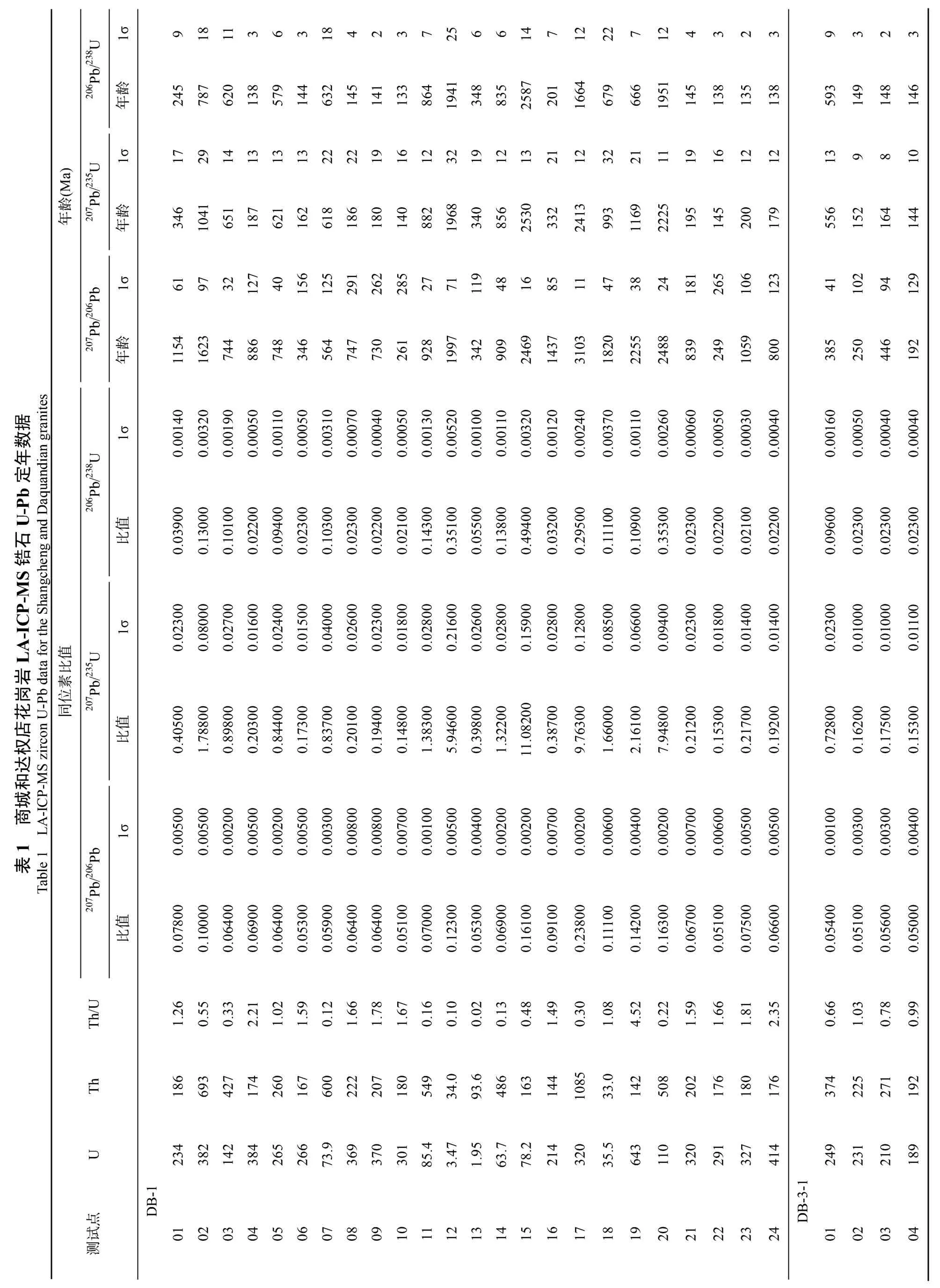
?
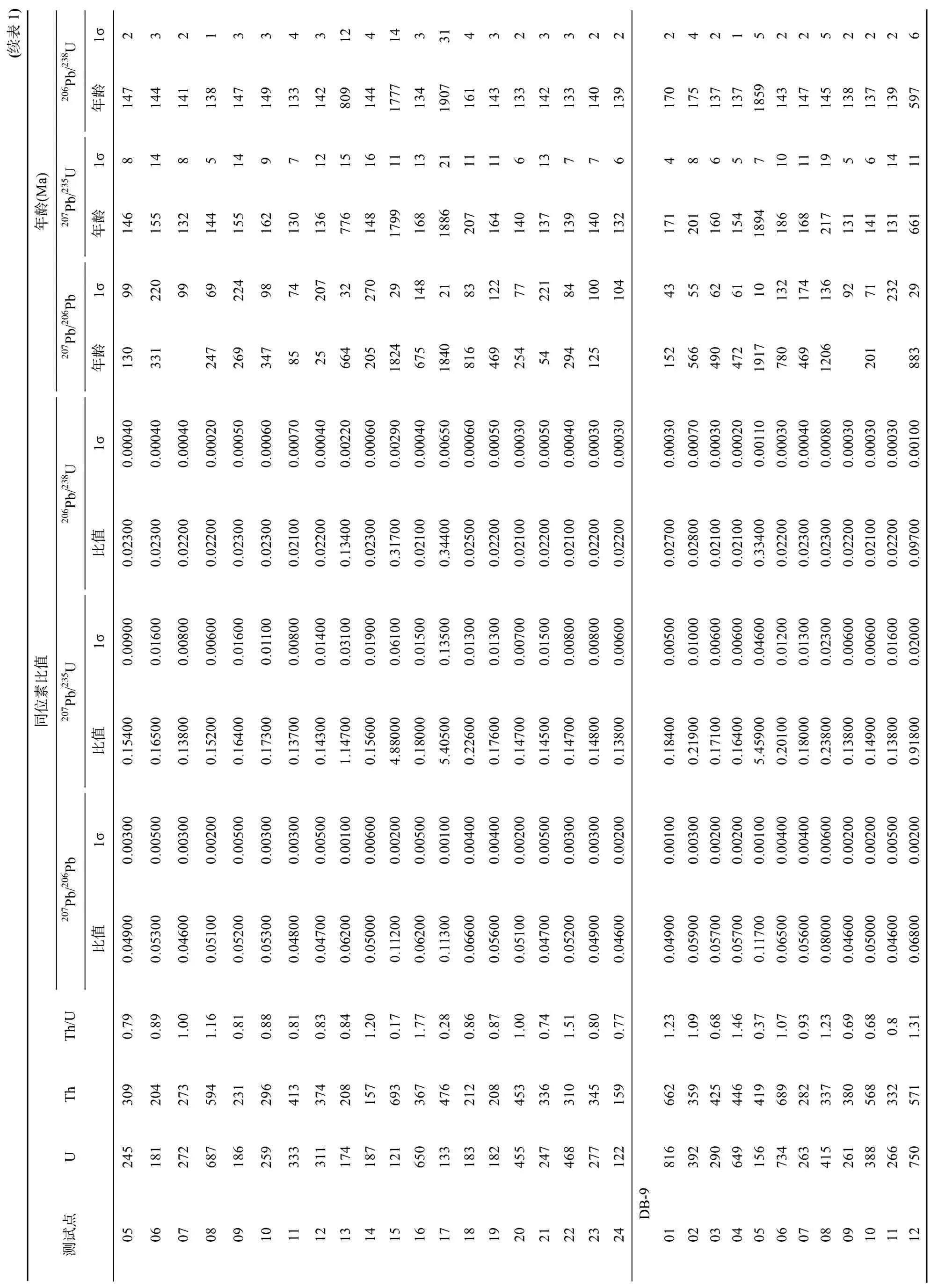
?

?

?
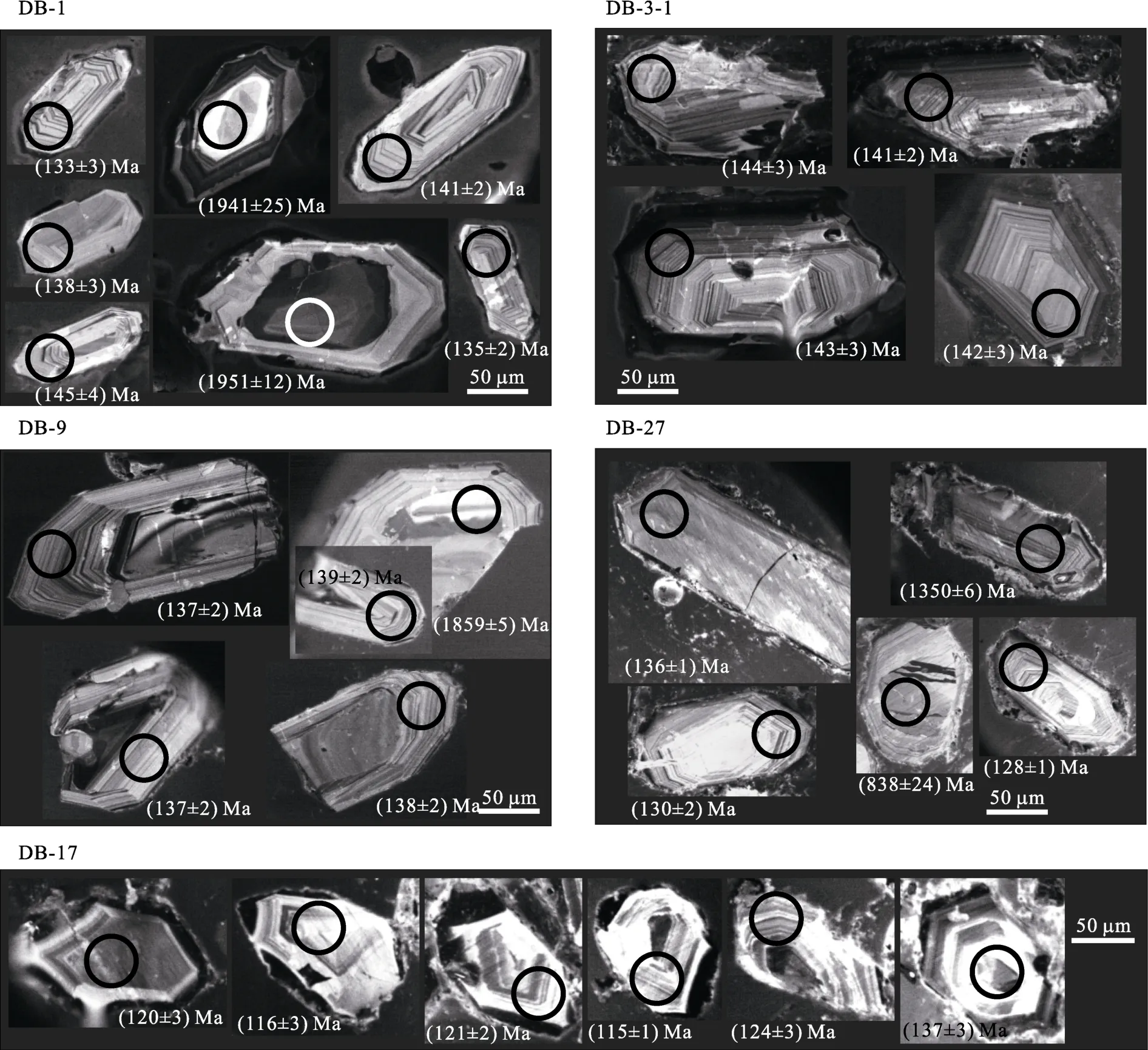
图3 商城和达权店花岗岩阴极射线发光(CL)图Fig.3 Cathodoluminance (CL) images of zircons from Shangcheng and Daquandian granites图中圆圈为U-Pb定年及Hf同位素测试激光点位, 直径40 μm。
图4f为商城岩体继承锆石(或继承核)年龄分布直方图, 图中反映商城岩体继承锆石的年龄主要集中于两个峰值, 分别为200~250 Ma和650~800 Ma,且继承锆石年龄普遍具有较低的Th/U比值, 这两个年龄段分别对应大别造山带 200~240 Ma期间的超高压变质作用和变质岩快速折返的时间[2,12,44–52]和北大别混合岩化的花岗质-英云闪长质片麻岩的原岩年龄[53–55]。此外, 从古元古代到古太古代继承锆石的大量存在, 反映商城岩体的成岩物质主要来自于较老的地壳物质。
4.2 主元素地球化学特征
商城和达权店岩体样品的主量元素分析结果列于表2。
商城岩体样品具较高的SiO2(68.04%~71.93%)、Na2O (4.13%~5.40%)、K2O (3.12%~4.65%)、CaO(1.47%~2.64%)含 量 , 和 较 低 的 TiO2(0.28%~0.50%)、Fe2O3T(1.44%~2.78)和 P2O5(0.08%~0.17%)含量。商城岩体样品Al2O3含量为 13.95%~15.93%,铝饱和指数 ACNK值(Al2O3/(CaO+Na2O+K2O)摩尔比)为0.91~1.01, ANK-ANCK分类图(图5)中主要落入准铝质范围。商城岩体具有较低的MgO (0.42%~1.08%)含量和 Mg#值(40.4~51.4)。在 K2O-SiO2图解(图6)中, 商城岩体的样品均落入高钾钙碱性系列。且商城岩体的三个侵入期次随时间由老到新表现出SiO2呈上升趋势, 除K2O含量与SiO2含量呈正相关关系外, 其他主元素均随 SiO2含量升高而降低, 表明各期次侵入体具有连续的演化趋势。
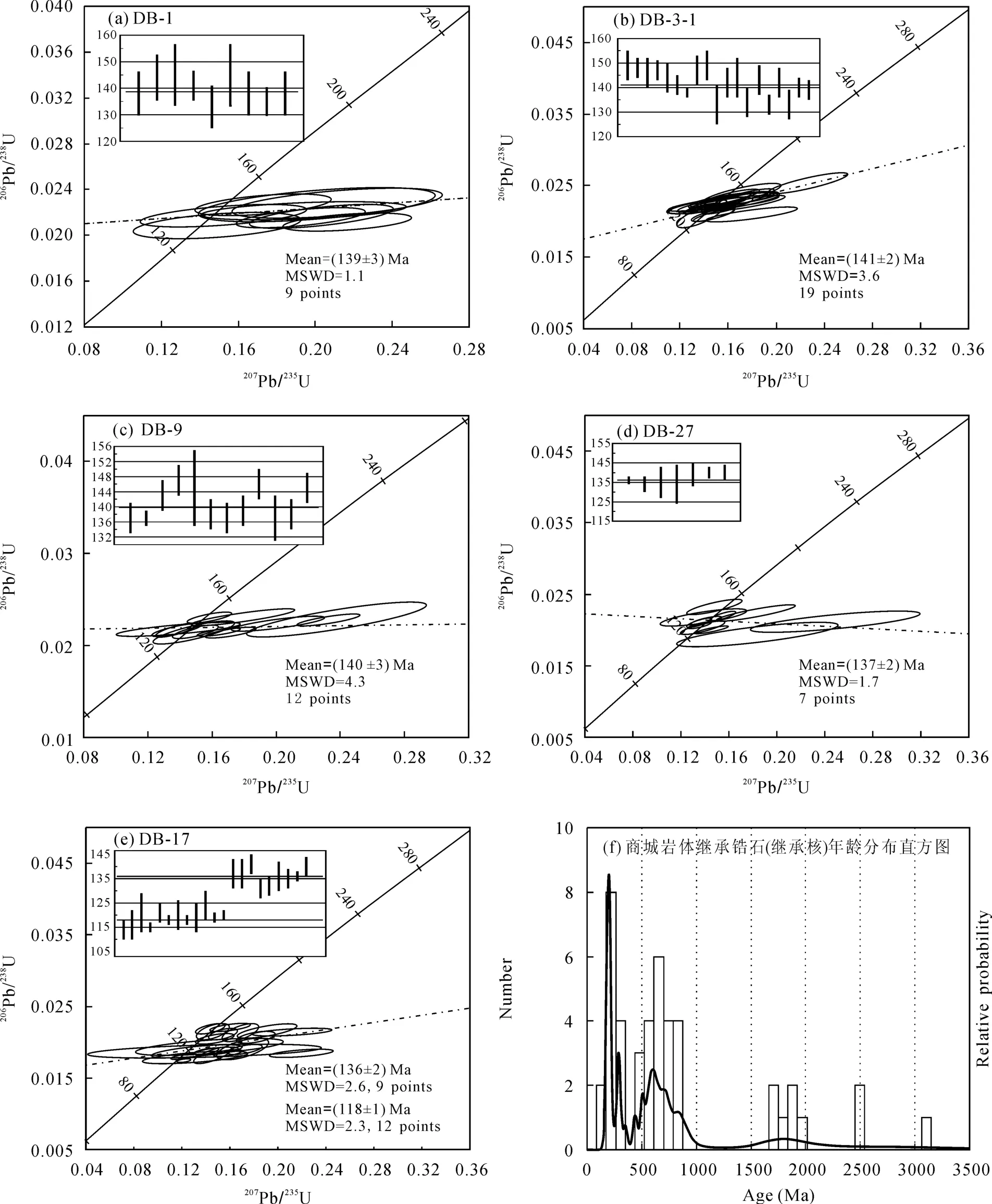
图4 商城和达权店花岗岩体LA-ICP-MS锆石U-Pb年龄谐和图Fig.4 LA-ICP-MS zircon U-Pb concordant diagrams for the Shangcheng and Daquandian granites
与商城岩体对比, 达权店岩体样品具有更高的SiO2(67.18%~76.83%)含量, 更低的 CaO (0.23%~2.27%)、TiO2(0.07%~0.56%)、Fe2O3T(0.30%~2.79%)和 P2O5(0.01%~0.19%)含量, 和相似的 Na2O(4.03%~4.58%)和 K2O (3.96%~4.66%)含量, Harker图解(图6)中, 两者呈连续的演化趋势。达权店岩体的Al2O3含量为12.92%~15.55%, 铝饱和指数ACNK值(Al2O3/(CaO+Na2O+K2O)摩尔比)为 0.98~1.11,ANK-ACNK分类图(图 5)中主要落入准铝质到弱过铝质范围。达权店岩体也具有低的 MgO (0.06%~0.68%)含量和中等偏高的 Mg#(32.8~49.6)值, 引起Mg#值偏高的原因也是非常低的铁含量。在K2O-SiO2图解(图6)中, 达权店岩体的样品落入高钾钙碱性系列。在Harker图解(图7)中各期次侵入体同样表现出由第1期侵入体到第3期侵入体, SiO2含量呈升高趋势, 表现出连续的演化趋势。
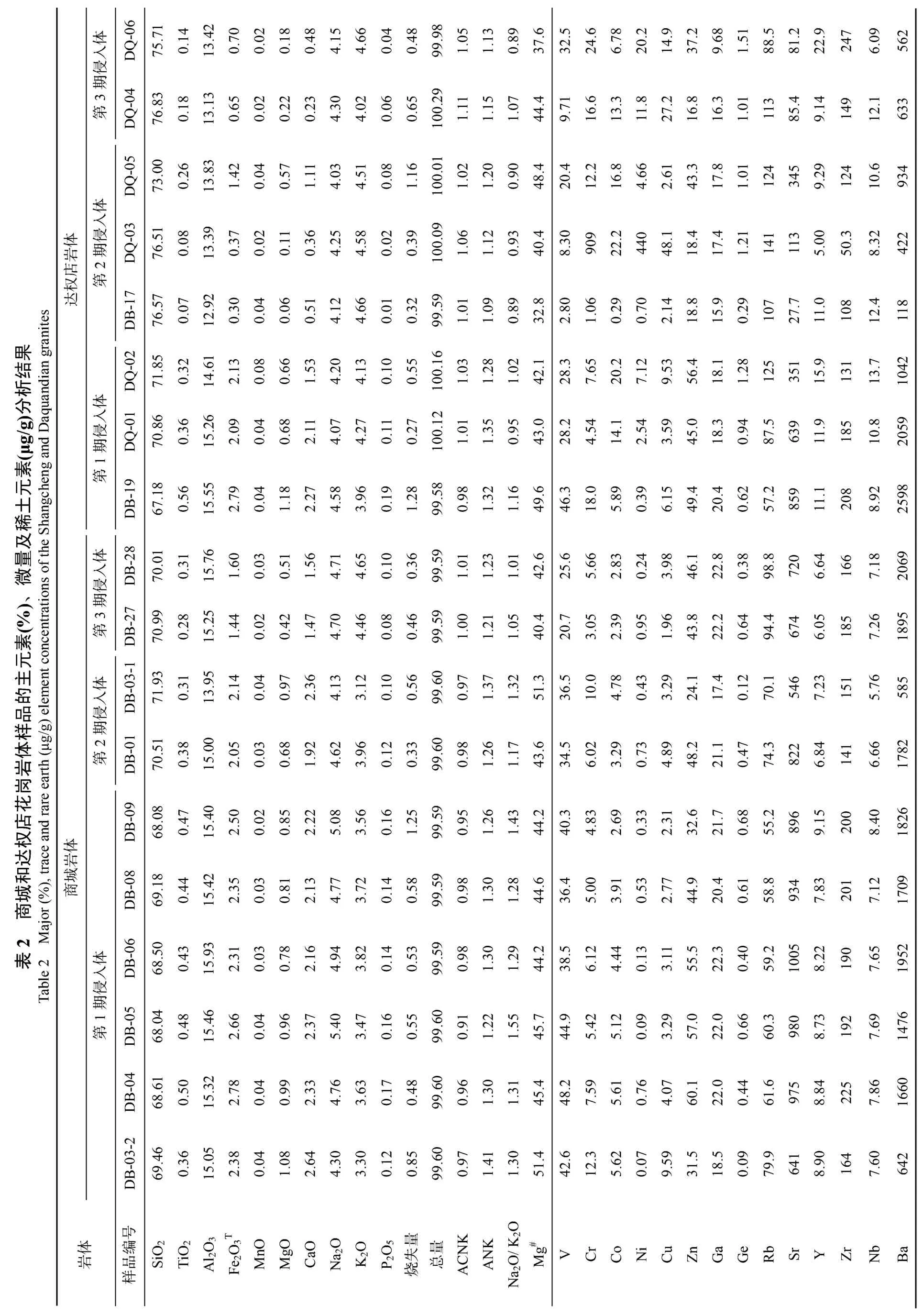
?

?

图5 商城和达权店花岗岩ANK-ACNK图解Fig.5 ANK-ACNK diagram of the Shangcheng and Daquandian granites

图6 商城和达权店花岗岩K2O-SiO2图解(样品符号同图5)Fig.6 K2O-SiO2 diagram of the Shangcheng and Daquandian granites(symbols are the same as Fig.5)
4.3 微量元素地球化学特征
商城岩体稀土总量主要介于102~216 μg/g之间,平均 180 μg/g; 达权店岩体稀土总量变化较大, 主要集中在 80.1~260 μg/g 之间, 平均 150 μg/g。两个岩体的球粒陨石标准化稀土元素分布模式均反映轻稀土相对富集, 重稀土亏损的特征(图8)。商城岩体的(La/Yb)N= 24.0~77.6, 平均 52.6, 达权店岩体(La/Yb)N= 5.03~55.4, 平均26.3。商城岩体样品Eu负异常不显著, δEu值变化于0.79~0.92之间; 达权店岩体样品 Eu负异常亦较小, 但较商城岩体明显(δEu= 0.43~0.84, 平均 0.67)。
在原始地幔标准化微量元素蛛网图(图8)上, 商城岩体样品均显示出较高的Ba (585~2069 μg/g, 平均 1560 μg/g)、Sr (546~1005 μg/g, 平均 819 μg/g)含量。达权店岩体的Ba、Sr含量变化较大, 但总体较商城岩体低, Ba = 118~2598 μg/g, 平均 1046 μg/g, Sr= 27.7~859 μg/g, 平均 313 μg/g。两个岩体的 Y 和Yb 的含量均较低, 商城岩体 Y = 6.05~9.15 μg/g, 平均 7.84 μg/g, Yb = 0.45~0.84 μg/g, 平均 0.58 μg/g;达权店岩体 Y = 5.00~22.9 μg/g, 平均 12.0 μg/g, Yb= 0.56~2.42 μg/g, 平均 1.23 μg/g。商城岩体的 Sr/Y比值为 72.0~122, 平均 105, 较达权店岩体更高(Sr/Y = 2.52~77.4, 平均 28.5)。商城岩体明显亏损Nb、Ta、P 和 Ti (图 8)。
在Sr-Yb图(图9)上, 商城岩体样品点大部分投影于张旗等[58]归纳出的高Sr低Yb花岗岩区域, 达权店岩体大部分投影于低Sr低Yb花岗岩区域, 且两个岩体不同侵位期次表现出随着年龄的增长Sr含量降低、Yb含量升高的趋势, 表明随时间源区深度逐渐变浅。
4.4 锆石Lu-Hf同位素
选择商城岩体3个单元已经做过年龄测试的样品(DB-1、DB-9、DB-27)和达权店岩体(DB-17)进行锆石原位 Hf同位素分析(表 3)。由于两个岩体中大量继承锆石及继承核的年龄范围较大, 因此其继承锆石的Hf同位素组成范围也较大。
商城岩体3个样品的岩浆期锆石的同位素组成相似,176Hf/177Hf同位素为0.281835~0.282249, 对应的 εHf(t)值均为负值, 集中于–30.2~ –15.6(表 3, 图10), 两阶段模式年龄集中于 2174~3079 Ma之间。达权店岩体岩浆期锆石中的176Hf/177Hf同位素为0.282050~0.282232, 对应的 εHf(t)值也均为负值, 集中于–23.2~ –16.7 之间(表 3, 图 10), 两阶段模式年龄集中于2227~2628 Ma之间。Hf同位素数据表明两个岩体均主要来自新太古代至古元古代陆壳物质。

图7 商城和达权店花岗岩主元素与SiO2的相关性图解(样品符号同图5)Fig.7 Co-variation of SiO2 with major elements and ratios for the Shangcheng and Daquandian granites (symbols are the same as Fig.5)
两岩体的继承锆石 Hf同位素的εHf(t)值和两阶段模式年龄具有较大的变化范围(图 11), εHf(t)值以负值为主, 两阶段模式年龄主要集中于新太古代-古元古代。
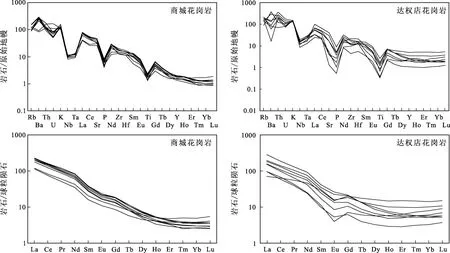
图8 商城和达权店岩体原始地幔标准化微量元素蛛网图与球粒陨石标准化稀土元素分布模式图Fig.8 PM-normalised incompatible element spider diagrams and chondrite-normalized REE patterns of the Shangcheng and Daquandian granites

图9 花岗岩Sr-Yb分类图(据文献[58])Fig.9 The classification of granitoids on the basis of Sr and Yb contents (after [58])
5 讨 论
5.1 成因类型
商城和达权店岩体的岩性主要为斑状黑云母二长花岗岩、二长花岗岩, 两岩体均属于具有高硅、富碱特征的高钾钙碱性、准铝至弱过铝质花岗岩(ACNK = 0.91~1.11)。两者主、微量元素地球化学特征相似, 除K2O外, 其他主元素均与SiO2含量呈负相关关系。由花岗岩主元素含量和Zr含量计算的锆石饱和温度大部分集中于 755~830 ℃之间(平均 774℃), 由于岩体富含继承锆石, 源区中锆石是饱和的,由于其Zr含量一部分是在继承锆石中, 而不全在熔体中, 因此计算得到的TZr代表了岩浆温度的上限[70]。
在Nb-Ga/Al和Y-Ga/Al图解中, 两个岩体主要投影于I型和S型花岗岩区域, 仅有个别样品落于I型和S型与A型花岗岩的交界处(图12a和12b)。在FeOT/MgO-(Zr+Nb+Ce+Y)图解中, 两岩体普遍落于未分异花岗岩范围, 与 A型花岗岩和分异型花岗岩不同(图 12c)。较低的锆石饱和温度(755~830 ℃(平均774 ℃))也与A型花岗岩高温的特征[72–73]有很大不同。两岩体均含有I型花岗岩的特征矿物角闪石,副矿物以榍石、磁铁矿、磷灰石常见, 缺少 S型花岗岩的特征富铝矿物, 且铝饱和指数ACNK值普遍小于1.1, 表明商城和达权店岩体具有I型花岗岩特征。此外, 实验研究表明, P2O5在弱过铝质和强过铝质岩浆中随 SiO2增加变化趋势不同, 这种性质也被成功地用于区分I型和S型花岗岩类[74–77]。在P2O5随SiO2变化的图解(图7)上, 数据点总体沿I型演化趋势分布, 即P2O5与SiO2含量呈负相关关系。表明商城和达权店花岗岩均为高钾钙碱性的 I型花岗岩。

表3 商城和达权店花岗岩锆石Hf同位素数据Table 3 Zircon Hf isotopic compositions of the Shangcheng and Daquandian granites

(续表 3)

图10 商城和达权店花岗岩体εHf(t)-t图解Fig.10 Plots of zircon εHf(t) values vs U-Pb age for the Shangcheng and Daquandian granites
5.2 岩石成因
根据微量元素和稀土元素分析, 商城岩体具有较典型的埃达克岩[78,79]的地球化学特征, 如 SiO2>56%、A12O3> 15%、Na2O ≥ 3.3%、高 Sr (> 400 μg/g)、不明显的 Eu负异常(0.79~0.92)、低 Y 和 Yb (Y< 15 μg/g、Yb < 1.9 μg/g)、富集 LREE、亏损 HREE等, 并具有较低的 Mg#值(40.4~51.4), 与大别山广泛出露的早白垩世低镁埃达克岩地球化学特征相似[23]。低的HREE、Y和Yb含量, 表明源区有石榴子石残留[80]。Sr在石榴子石、角闪石和单斜辉石中分配系数很小(分别为 0.015、0.058和 0.2), 而在斜长石中很大, 因此岩石的Sr正异常和高Sr/Y比值表明岩浆源区的斜长石在岩浆形成过程中由于高压条件发生分解作用进入熔体[79]。样品对原始地幔的蛛网图上可以看出商城岩体明显亏损Nb、Ta和Ti, 这可能与金红石的分离结晶或源区残留有关[81–82]。实验研究表明, 当玄武岩熔融形成含金红石的榴辉岩时, 熔体强烈亏损 Nb和 Ta[83–84], 因此残留相中金红石的产出会导致熔融的花岗岩贫 Nb、Ta、Ti等元素[85–87]。在 Sr/Y-Y和(La/Yb)N-YbN图解(图 13)中, 商城岩体的样品点大部分投影于太古宙TTG与埃达克岩范围内, 且在Sr/Y-Y图上全部落于加厚下地壳熔融形成的埃达克岩范围内。从图上可以看出, 商城岩体主要落于含 10%石榴子石的角闪岩相和榴辉岩相的熔融曲线之间, 表明岩石主要是由榴辉岩或石榴石角闪岩相的基性岩石发生低程度部分熔融作用形成。
结合熔融曲线和商城岩体的地球化学特征, 推测残留相主要以石榴子石、角闪石、金红石为主。石榴子石稳定出现的压力至少大于0.8~1.0 GPa, 通常大于1.5 GPa(以金红石的出现为标志)[80], 因此商城岩体岩浆部分熔融压力大于1.5 GPa, 相应的深度至少大于50 km。

图11 商城和达权店岩体锆石Hf同位素εHf(t)和两阶段模式年龄直方图Fig.11 Histograms of zircon εHf(t) and tDM2 for the Shangcheng and Daquandian granites

图12 商城和达权店岩体Nb-Ga/Al、Y-Ga/Al和FeOT/MgO-(Zr+Nb+Ce+Y)图解(据文献[71], 样品符号同图5)Fig.12 Nb vs. Ga/Al, Y vs. Ga/Al and FeOT/MgO vs. Zr+Nb+Ce+Y diagrams of the Shangcheng and Daquandian granites (after [71]; symbols are the same as Fig.5)
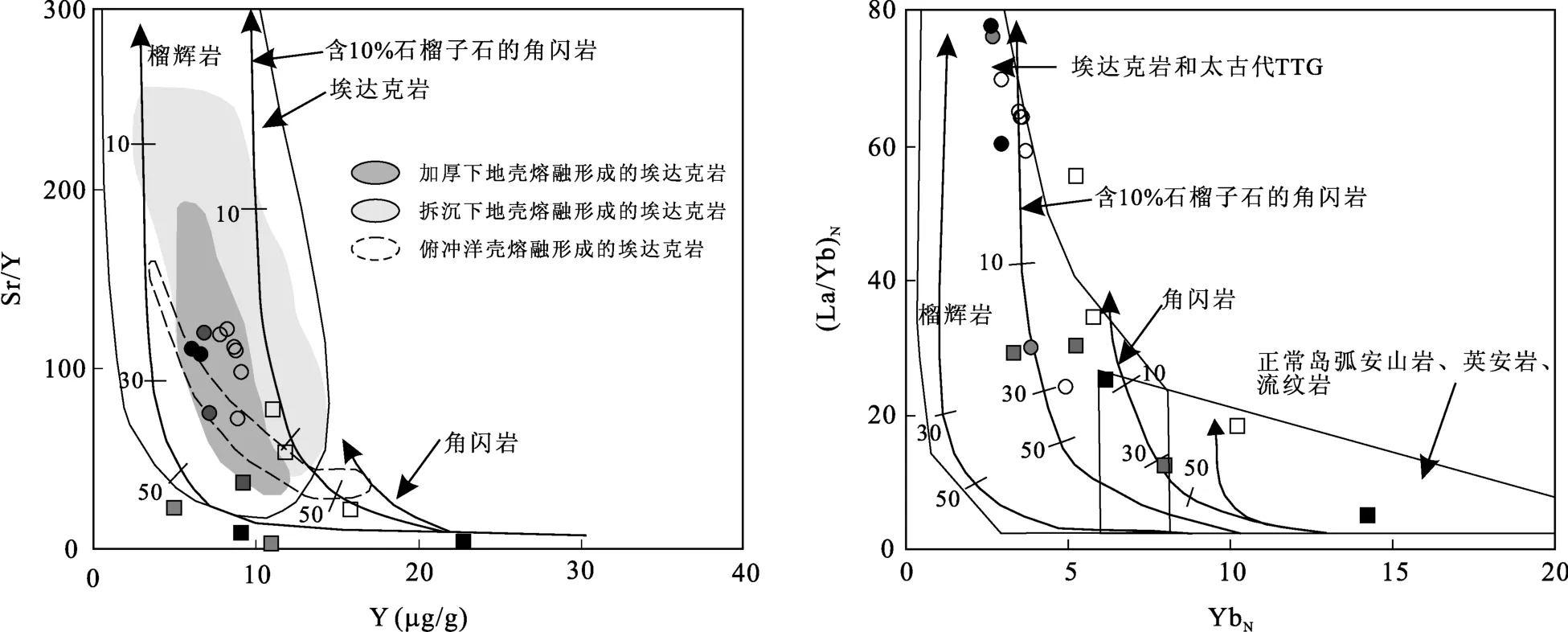
图13 商城和达权店岩体的Sr/Y-Y和(La/Yb)N-YbN图解(据文献[88]; 样品符号同图5)Fig.13 Plots of Sr/Y vs Y and (La/Yb)N vs YbN for the Shangcheng and Daquandian granites (after [88]; symbols are the same as Fig.5)
近年来的研究表明, 玄武质岩浆底侵提供热源促使加厚的下地壳(>50 km)基性岩石的部分熔融[79–94], 以及拆沉作用引起的下地壳玄武质岩石的部分熔融[95–99]可能是中国东部增厚下地壳减薄的两个重要机制。在主要氧化物和微量元素与SiO2图解(图 14)中, 商城岩体的成分点均落入增厚下地壳熔融形成的埃达克质岩区域内, 与拆沉下地壳熔融形成的埃达克质岩差别较大。因此, 商城岩体主要是幔源岩浆底侵促使下地壳部分熔融形成的。根据Barbarin[101]的花岗岩类分类方案, 商城岩体属于富钾的钙碱性斑状二长花岗岩类(K-rich and K-feldspar porphyritic calc-alkaline granitoids; KKG), 这类花岗岩能够很好地指示地球动力学背景, KGG形成于造山带造山作用结束后大陆板块从挤压向伸展转换的构造环境, 标志着大别造山带垮塌的开始, 即厚的地壳伸展减薄的开始。

图14 商城和达权店岩体主元素与SiO2图解(据文献[23,88,100]; 样品符号同图5)Fig.14 Major elements vs.SiO2 plots of the Shangcheng and Daquandian granites (after [23,88,100]; symbols are the same as Fig.5)
商城和达权店岩体都具有多阶段多期次侵入的特点, 且两个岩体各期次侵入体的岩石学和地球化学特征均有所差别, 即晚期侵入体相比早期侵入体含有更高的SiO2含量、ACNK值, 低的稀土元素总量、Sr含量和Sr/Y比值。这些地球化学特征的演变,反了从早期侵入体到晚期侵入体, 岩浆演化程度更高, 形成压力逐渐降低, 形成深度相对变浅。其中,达权店岩体是燕山晚期岩浆活动的产物, 比商城岩体具有更高的SiO2含量, 低的Ba、Sr含量, 同时亏损 Nb、Ta、Sr、P、Ti和 Eu等元素(图 8), 指示其母岩浆经历了分离结晶演化[76]。在Ba-Sr、Rb-Sr对数图解(图 15)上, 达权店岩体随着 Ba含量的升高,Sr沿钾长石结晶分异演化线快速的从27.7 μg/g增加到 859 μg/g, 这种变化趋势也进一步证明了岩体在形成过程中主要经历了钾长石和斜长石的分异, 而商城岩体没有表现出明显的结晶分异演化趋势。虽然达权店岩体中Y、Yb含量较低, 相当于埃达克质岩的 Y、Yb含量, 且亏损重稀土, 表明源区可能有石榴子石存在。但岩体贫Sr、低Al, 有比较明显的Eu负异常, 说明残留相中有斜长石存在。在 Sr-Yb分类图解(图9)上, 达权店岩体主要分布于张旗等[58]归纳的低Sr、低Y花岗岩范围, 是在中等压力下形成的, 较商城岩体岩浆来源深度浅, 推测其残留相为斜长石、石榴子石、辉石, 表明此时地壳厚度较商城岩体形成时明显减薄。Sr/Y-Y图解(图 13)中落在埃达克岩和正常岛弧安山岩、英安岩、流纹岩的过渡区域, 说明了其形成于厚的地壳向正常地壳厚度过渡或转变的环境(与斜长石相平衡的源区环境)。从商城岩体到达权店岩体从早到晚形成的源区环境由石榴子石相平衡向斜长石相平衡的转变, 即地壳由厚变薄。
5.3 物质源区
锆石Hf同位素特征显示, 商城和达权店岩体岩浆期锆石的 εHf(t)值分别集中于–30.2~ –15.6 和–23.2~ –16.7 之间, tDM2值分别为 2173~3079 Ma和2227~2628 Ma, 表明两个岩体源于古老的地壳岩石的部分熔融。Zhang et al.[103]根据Sr-Nd-Pb同位素组成对比认为大别山白垩纪不同构造单元花岗岩类的同位素组成相似, 并且与岩石类型关系不大, 它们应来源于基本相似的深部陆壳物质源区。且不同构造单元早白垩纪花岗岩类的εHf值 (t = 128~132 Ma)= –15.1~ –30.5, tDM2= 2133~3100 Ma[19,65]与商城和达权店岩体的Hf同位素组成也基本一致, 表明商城和达权店岩体应均来源于与大别山其他地区早白垩世花岗岩体基本相似的深部陆壳物质源区(图16)。

图15 商城和达权店岩体造岩矿物结晶分异判别图解(据文献[102]; 样品符号同图5)Fig.15 Ba vs Sr and Rb vs Sr plots for the Shangcheng and Daquandian granites (after [102]; symbols are the same as Fig.5)
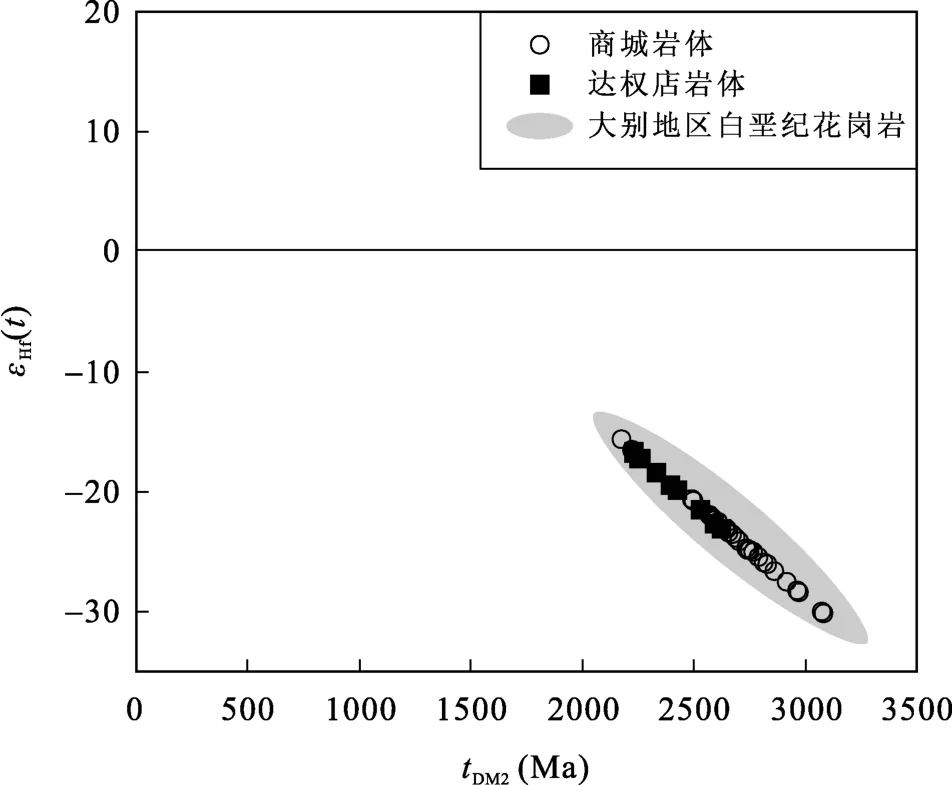
图16 商城和达权店岩体与北大别白垩纪花岗岩Hf同位素组成对比(北大别早白垩纪花岗岩Hf同位素组成范围根据文献[19,63,65]Fig.16 Hf isotopic composition of the Shangcheng, Daquandian and North Dabie Cretaceous granites (Hf isotopic data of the North Dabie Cretaceous granites are from [19,59,61]
商城岩体和达权店岩体岩浆期锆石的 εHf(t)值具有很大的变化范围(图 10), 表明源区组成并不均一, 原始岩浆不是单一组分。变化很大的继承锆石年龄也表明混入不同年龄的地壳物质在花岗岩源区中。商城岩体存在大量继承锆石, 除了一个 3.1Ga和两个约2.5 Ga的年龄之外, 其他继承锆石年龄主要集中于三叠纪、新元古代和约1.7~2.0 Ga的古元古代中晚期, 与大别-苏鲁造山带各构造单元广泛出露的早白垩世岩浆岩的继承锆石年龄情况基本一致[17,19,20,104,105]。其中新元古代(约750 Ma)和三叠纪(约 230 Ma)的继承锆石 U-Pb年龄与大别苏鲁造山带超高压变质岩的原岩和变质年龄一致[53,106,107],古元古代(1.7~2.0 Ga)和太古宙(2.5~3.1 Ga)U-Pb 年龄与崆岭杂岩中TTG片麻岩和混合岩的原岩侵位年龄一致[17,66–68,108,109], 这些年龄特征暗示商城和达权店岩体与大别超高压变质岩及崆岭杂岩可能具有亲源性。
前人研究表明大别-苏鲁造山带早白垩世后碰撞花岗岩与北大别超高压片麻岩具有相似的Sr、Nd同位素组成[103–104]。Ma et al.[110]也认为早白垩世花岗岩和花岗斑岩为大别杂岩深熔的产物。Bryant et al.[17]认为花岗岩不仅由北大别片麻岩部分熔融形成,源岩中还需要更加古老的地壳物质, 如太古宙崆岭杂岩。大别杂岩是大别造山带穹窿构造的核部组成,其中北大别杂岩是大别核部杂岩单元的主要组成部分, 由以灰色片麻岩为主的长英质片麻岩、以斜长角闪岩为主的铁镁质岩和基性麻粒岩组成, 主体变质属于角闪岩相, 且近年研究提出作为核杂岩主体的长英质片麻岩中存在原岩为岩浆成因的 TTG岩系[111–113]。长英质片麻岩的原岩年龄为 700~800 Ma[114,53–55], 混合岩化年龄为 120~140 Ma[11–12]; 残存的麻粒岩原岩年龄为 2600~2700 Ma和 3400 Ma(继承核), 早期麻粒岩相变质年龄为 2000~2200 Ma[115–116], 主要的锆石 Hf模式年龄为古元古代(1.9 Ga)[69]。前人普遍认为北大别杂岩的原岩属性是被新元古代 Rodinia超大陆裂解改造的扬子克拉通北缘大陆俯冲陆壳基底, 并夹杂少量(古)太古宙古老残片, 曾经受过榴辉岩相变质作用[11,12,53,55,117]。目前已知的扬子克拉通北缘最古老的基底是崆岭群高级变质地体。崆岭地体主要的岩石组合为 TTG片麻岩,变沉积岩和局部保存有基性麻粒岩的斜长角闪岩。对崆岭变质岩进行的多种方法的定年工作认为其原岩形成时代为 2.85~3.2 Ga[66,68,109,118–121]。此外, 高山等[122]还给出了1992 Ma的变质年龄和3.3 Ga的碎屑锆石。这些锆石具有负的εHf(t)值和古老的两阶段模式年龄(3.6 Ga)(图10)。路凤香等[94]利用Pb同位素对比和岩浆熔融模拟计算认为大别下地壳中存在类似崆岭群的岩层, Ma et al.[21]通过亏损地幔与崆岭群TTG片麻岩两端元混合计算模拟, 也得出崆岭群可能广泛分布于大别造山带中生代地壳深部的认识。
商城和达权店岩体的同位素特征显示岩浆期锆石 Hf同位素的两阶段模式年龄分别为 2174~3079 Ma和2227~ 2628 Ma, 明显老于北大别片麻岩古元古代的锆石 Hf模式年龄(1.9 Ga)[69], 因此, 花岗岩不应该只形成于北大别片麻岩的部分熔融[123], 而需要包括更多古老太古宙地壳物质。图10中, 所有的花岗岩的锆石 εHf(t)值都在北大别片麻岩和崆岭群TTG片麻岩的地壳演化线之间, 这表明花岗岩主要来自于北大别片麻岩, 并可能含有更古老的崆岭群物质。
5.4 构造环境
大量的地质年代学研究表明, 大别造山带广泛出露的高压-超高压榴辉岩相变质作用主要出现在240~220 Ma[45–52,124]。这些年龄被看作为扬子克拉通陆壳向北俯冲于华北克拉通之下[2]以及超高压变质作用之后岩石剥露和冷凝的时间[125]。在板块聚合的过程中, 大陆板块的深俯冲/碰撞普遍导致大陆造山带下加厚地壳的形成[126], 从挤压向伸展的转换则更晚。Liu et al.[127]通过对大别山地区中生代的盆地分析认为伸展作用可能始于晚侏罗世-早白垩世左右, 马昌前等[128]通过岩浆作用的研究进一步指出碰撞后强烈增厚的地壳开始趋于伸展减薄, 伸展作用可能始于早白垩世。
大别山地区有若干同商城岩体地球化学特征相似, 也具有高Sr/Y比值和亏损重稀土元素特征的埃达克质岩侵位, 其锆石 U-Pb年龄介于 140~130 Ma之间[11,12,15,20,28,30,128,129], 这些花岗岩体被认为是增厚的玄武质下地壳部分熔融的产物, 但此时的构造环境已经不是挤压体制。商城岩体侵位年龄为137~141 Ma, 属于富钾的钙碱性二长花岗岩类, 形成于造山带造山作用结束后大陆板块从挤压向伸展转换的构造环境, 标志着大别造山带垮塌的开始,即厚的地壳伸展减薄的开始。岩石圈减薄可以使地壳岩石因减压而熔融[130–131]。然而, 没有深部地幔物质或热源的供给, 单纯增厚地壳的减压熔融只能形成小规模的岩体, 缺少足够的热量不可能形成大规模的岩浆活动[131–132], 应有外来热源的加入使岩浆源区大规模熔融[70]。通常认为幔源岩浆活动(特别是基性岩浆的底侵和侵入)提供的热是导致地壳物质重熔形成花岗岩的重要因素, 地幔与地壳之间的热传递被认为是地壳熔融的主要方式, 而最有效的方式是通过幔源岩浆底侵作用将地幔热传递到下地壳引发熔融形成中酸性岩浆[133], 同时伴随基性岩浆作用。
前人对大别地区零星分布的早白垩世辉石岩-辉长岩侵入体、基性岩墙/脉和基性火山岩的研究得到这一期基性岩浆活动主要集中于 120~130 Ma范
围[27,30,93,109,134–138]。陈道公等[139]对大别山北部道士冲辉石岩进行了锆石微区离子探针 U-Pb定年研究,得到年龄变化于159~134 Ma之间, 且大量测试点的年龄数据主要集中于138~148 Ma范围, 加权平均年龄是(144.5±6.2) Ma, 与商城岩体形成年龄相近。岩石地球化学研究表明道士冲辉石岩母岩浆为地幔基性熔体, 并经历了与基性下地壳物质的相互作用[140], 表明大别地区早白垩世岩浆活动最早可以追溯到约 145 Ma。这与早白垩世花岗岩同位素年龄集中于111~143 Ma范围, 但峰期在 125~130 Ma相对应[11–20,104], 表明深部基性熔体是促使下地壳发生部分熔融形成早白垩世花岗岩的主要热源。
马昌前等[128]根据大别山地区高 Sr/Y比值花岗岩年龄为(135.7±2.7) Ma, 而铁镁质岩体和性质类似达权店花岗岩体的具有 Sr-Eu负异常的花岗岩的同位素年龄为105~130 Ma, 认为大别山造山带的减薄作用发生在约135 Ma。Xie et al.[18]认为北大别花岗岩体锆石 U-Pb年龄(128±2) Ma代表最小拉张起始时间。吴元保等[141]根据北大别混合岩化作用的年龄结果, 认为大别地区构造体制转换的时间为(137±4)Ma。由于伸展作用引起的地壳部分熔融和花岗岩侵位一般会稍晚于部分熔融作用发生的时间, 所以一般把加厚地壳开始发生熔融作用的时间看作为构造体制转换发生的时间的最小值[142–144]。因此, 根据商城岩体的年龄结果, 我们认为北淮阳地区构造体制转换的最小时间为(137±2) Ma。
续海金等[65]根据早白垩纪两期花岗岩类的形成时间间隔认为大别造山带在很短的几个 Ma内(约4~6 Ma)快速伸展垮塌, 所得结论主要来自北大别地区的花岗岩体。本文研究的达权店岩体的形成年龄为(118±1) Ma, 为过铝质的高钾钙碱性花岗岩,部分熔融深度明显比商城岩体浅, 形成于厚的地壳向正常地壳厚度过渡或转变的环境, 但地壳厚度可能仍大于正常地壳厚度, 表明研究区在(118±1) Ma时, 加厚地壳虽已经减薄, 但还未彻底伸展垮塌。由此可见, 北淮阳地区的加厚地壳的构造体制演化过程在时间上与北大别地区有所不同。
此外, 商城地区花岗岩体中常见辉绿岩墙, 这些基性岩墙的SHRIMP锆石U-Pb年龄范围很宽, 但主要为燕山期年龄(137.1~117.8 Ma)[42]。这类岩墙/岩脉在北淮阳地区十分常见, 形成时代集中于约120 Ma[145], 与岩石圈伸展环境下富集地幔的部分熔融有关[28,28,146]。基性岩墙的侵位代表了强烈的伸展作用已经开始, 进一步证明了深部地幔物质是下地壳部分熔融的热源[131–132]。
从商城岩体到达权店岩体, 岩体形成压力逐渐降低, 反映了花岗岩浆活动的源区或岩浆房逐渐向浅部迁移。而其后基性岩墙、岩脉的侵入, 表明岩浆源区由壳源向幔源演化。商城和达权店岩体的形成反映了地壳从挤压加厚向伸展减薄转换的过程。
6 结 论
(1) 商城和达权店花岗岩体位于西大别隆起带北部, 主要岩性为二长花岗岩, 锆石的U-Pb谐和年龄分别为(137±2)~(141±2) Ma和(118±1) Ma。两者地球化学特征相似, 均为准铝质-弱过铝质高钾钙碱性I型花岗岩。
(2) 两岩体均具有轻稀土富集、重稀土亏损的稀土元素分布模式及Nb、Ta负异常特征。商城岩体Eu负异常不显著, Sr、Ba含量较高, Y和Yb含量较低, Sr/Y比值高, 是加厚下地壳熔融的产物, 岩浆来源深度大于50 km。达权店岩体Eu负异常明显, Sr、Ba、Y和Yb含量及Sr/Y比值均较低, 岩浆来源深度较浅, 形成时期地壳厚度较商城岩体形成时期明显减薄。从早白垩世早期 的 商城岩体到早白垩晚期达权店岩体的侵入, 反映了花岗岩浆活动的源区或岩浆房逐渐向浅部迁移, 及地壳从挤压加厚向伸展减薄转换的过程
(3) 通过继承锆石及Hf同位素组成的对比认为,两个岩体的源岩均主要来自北大别片麻岩, 并可能含有更古老的崆岭群物质。
:
[1] 张国伟, 张本仁, 袁学诚, 肖庆辉. 秦岭造山带与大陆动力学[M]. 北京: 科学出版社, 2001: 1–87.Zhang Guo-wei, Zhang Ben-ren, Yuan Xue-cheng, Xiao Qing-hui. Qinling Orogenic Belt and Continental Dynamics[M]. Beijing: Science Press, 2001: 1–87 (in Chinese with English abstract).
[2] Li Shuguang, Xiao Yilin, Liou Deliang, Chen Yizhi, Ge Ningjie, Zhang Zongqing, Sun Shensu, Cong Bolin, Zhang Ruyuang, Hart S R, Wang Songshan. Collision of the North China and Yangtse Blocks and formation of coesite-bearing eclogites: Timing and processes [J]. Chem Geol, 1993,109(1–4): 89–111.
[3] Zheng Yongfei, Fu Bin, Xiao Yilin, Li Yiliang, Gong Bing.Hydrogen and oxygen isotope evidence for fluid-rock interactions in the stages of pre- and post-UHP metamorphism in the Dabie Mountains [J]. Lithos, 1999, 46(4): 677–693.
[4] 从柏林, 王清晨. 大别山-苏鲁超高压变质带研究的最新进展[J]. 科学通报, 1999, 44(11): 1127–1141.Cong Bolin, Wang Qingchen. The Dabie-Sulu UHP rocks belt:Review and prospect [J]. Chinese Sci Bull, 1999, 44(12):1028–1032.
[5] 李曙光. 大陆俯冲化学地球动力学[J]. 地学前缘, 1998,5(4): 211–233.Li Shu-guang. Chemical geodynamics of continental subduction [J]. Earth Sci Front, 1998, 5(4): 211–233 (in Chinese with English abstract).
[6] 董树文, 武红岭, 刘晓春, 薛怀民. 陆-陆点碰撞与超高压变质作用[J]. 地质学报, 2002, 76(2): 163–172.Dong Shu-wen, Wu Hong-ling, Liu Xiao-chun, Xue Huai-min.On continent-continent point-collision and ultrahigh-pressure metamorphism [J]. Acta Geol Sinica, 2002, 76(2): 163–172(in Chinese with English abstract).
[7] Meng Qingren, Zhang Guowei. Geologic framework and tectonic evolution of the Qinling orogeny, central China [J].Tectonophysics, 2000, 323(3/4): 183–196.
[8] Ratschbacher L, Hacker B R, Calvert A, Webb L E, Grimmer J C, McWilliams M O, Ireland T, Dong Shuwen, Hu Jianmin.Tectonics of the Qinling (Central China): Tectonostratigraphy,geochronology, and deformation history [J]. Tectonophysics,2003, 366(1/2): 1–53.
[9] 索书田, 钟增球, 游振东. 大别-苏鲁超高压-高压变质带伸展构造格架及其动力学意义[J]. 地质学报, 2001, 75(1):14–24.Suo Shu-tian, Zhong Zeng-qiu, You Zhen-dong. Extensional tectonic framework of the Dabie-Sulu UHP-HP metamorphic belt, Central China, and its geodynamical significance [J].Acta Geol Sinica, 2001, 75(1): 14–24 (in Chinese with English abstract).
[10] 李曙光, 黄方, 李晖. 大别-苏鲁造山带碰撞后的岩石圈拆离[J]. 科学通报, 2001, 46(17): 1487–1491.Li Shuguang, Huang Fang, Li Hui. Post-collisional lithosphere delamination of the Dabie-Sulu orogen [J]. Chinese Sci Bull, 2002, 47(3): 259–263.
[11] Xue Feng, Rowley D B, Tucker R D, Peng Zhanxiang. U-Pb zircon ages of granitiod rocks in the north Dabie complex,eastern Dabie Shan, China [J]. J Geology, 1997, 105(6):744–753.
[12] Hacker B R, Ratschbacher L, Webb L, Ireland T, Walker D,Dong Shuwen. U/Pb zircon ages constrain the architecture of the ultrahigh-pressure Qiling-Dabie orogen, China [J]. Earth Planet Sci Lett, 1998, 161(1–4): 215–230.
[13] Wei Chunjing, Zhang Lifei, Wang Shiguang. Mesozoic high-K granitic rocks from the eastern Dabie Mountains, Central China and their geological implications [J]. Sci China (D),2001, 44(6): 525–534.
[14] 刘敦一, 汤加富, 周存亭, 高天山, 沈荷生, 杨淳. 大别造山带核部桃园寨火山岩锆石U-Pb定年及其地质意义[J]. 地质学报, 2002, 76(2): 217–221.Liu Dun-yi, Tang Jia-fu, Zhou Cun-ting, Gao Tian-shan, Shen He-sheng, Yang Chun. U-Pb zircon dating and its geological significance of the Taoyuanzhai volcanic rock, central Dabie orogenic belt [J]. Acta Geol Sinica, 76(2): 217–212 (in Chinese with English abstract).
[15] 薛怀民, 董树文, 刘晓春. 北大别东部白垩纪埃达克质火山岩及其锆石 U-Pb年代学[J]. 地球化学, 2002, 31(5):455–463.Xue Huai-min, Dong Shu-wen, Liu Xiao-chun. U/Pb zircon dating for Cretaceous adakitic volcanic rocks in eastern part of the North Dabie mountains [J]. Geochimica, 2002, 31(5):455–463 (in Chinese with English abstract).
[16] Ma Changqian, Yang Kunguang, Ming Houli, Lin Guangchun.The timing of tectonic transition from compression to extension in Dabieshan: Evidence from Mesozoic granites [J]. Sci China (D), 2004, 47(5): 453–462.
[17] Bryant D L, Ayers J C, Gao Shan, Miller C F, Zhang Hongfei.Geochemical, age, and isotopic constraints on the location of the Sino-Korean/Yangtze Suture and evolution of the Northern Dabie complex, east central China [J]. Geol Soc Am, 2004,116(5/6): 698–717.
[18] Xie Zhi, Zheng Yongfei, Zhao Zifu, Wu Yuanbao, Wang Zhengrong, Chen Jiangfeng, Liu Xiaoming, Wu Fuyuan.Mineral isotope evidence for the contemporaneous process of Mesozoic granite emplacement and gneiss metamorphism in the Dabie Orogen [J]. Chem Geol, 2006, 231(3): 214–235.
[19] Xu Haijin, Ma Changqian, Ye Kai. Early Cretaceous granitoids and their implications for Collapse of the Dabie orogen,eastem China: SHRIMP zircon U-Pb dating and geochemistry[J]. Chem Geol, 2007, 240(3/4): 238–259.
[20] Zhao Zifu, Zheng Yongfei, Wei Chunsheng, Wu Yuanbao.Post-collisional granitoids from the Dabie orogen in China:Zircon U-Pb age, element and O isotope evidence for recycling of subducted continental crust [J]. Lithos, 2007, 93(3/4):248–272.
[21] Ma Changqian, Ehlers C, Xu Changhai, Li Zhichang, Yang Kunguang. The roots of the Dabieshan ultrahigh-pressure meyamorphic terrane: Constraints from geochemistry and Nd-Sr isotope systematics [J]. Precamb Res, 2000, 102(3/4):279–301.
[22] 马昌前, 杨坤光, 许长海, 李志昌, Ehlers C. 大别山中生代钾质岩浆作用与超高压变质地体的剥露机理[J]. 岩石学报,1999, 15(3): 379–395.Ma Chang-qian, Yang Kun-guang, Xu Chang-hai, Li Zhi-chang, Ehlers C. Mesozoic potassic magmatism in the Dabie Mountains: Implication for exhumation mechanism of ultrahigh-pressure metamorphic terranes [J]. Acta Petrol Sinica, 1999, 15(3): 379–395 (in Chinese with English abstract).
[23] Wang Qiang, Wyman D A, Xu Jifeng, Jian Ping, Zhao Zhenhua, Li Chaofeng, Xu Wei, Ma Jinlong, He Bin. Early Cretaceous adaktie granites in the Northern Dabie Complex, centrai China: Implications for partial melting and delamination of thickened lower crust [J]. Geochim Cosmochim Aeta, 2007,71(10): 2609–2636.
[24] 王强, 赵振华, 熊小林. 桐柏-大别造山带燕山晚期 A型花岗岩的厘定[J]. 岩石矿物学杂志, 2000, 19(4): 297–315.Wang Qiang, Zhao Zhen-hua, Xiong Xiao-lin. The ascertainment of late-Yanshanian A-type granite in Tongbai-Dabie orogenic belt [J]. Acta Petrol Mineral, 19(4): 297–315 (in Chinese with English abstract).
[25] 李曙光, 聂永红, 郑双根, 刘德良. 俯冲陆壳与上地幔的相互作用—— I. 大别山同碰撞镁铁-超镁铁岩的主要元素及痕量元素地球化学[J]. 中国科学(D 辑), 1997, 27(6):488–493.Li Shuguang, Nie Yonghong, Zheng Shuanggen, Liu Deliang.Interaction between subducted continental crust and the mantle — I. Major and trace element geochemistry of the syncollisional mafic-ultramafic intrusions in the Dabie Mountains[J]. Sci China (D), 1998, 41(5): 545–552.
[26] 李曙光, 聂永红, Hart S R, 郑双根. 上地幔-俯冲陆壳相互作用—— II. 北大别同碰撞镁铁-超镁铁质岩侵入岩的Sr-Nd同位素制约[J]. 中国科学(D辑), 1998, 28(1): 18–22.Li Shuguang, Nie Yonghong, Hart S R, Zheng Shuanggen.Upper mantle-deep subducted continental crust interaction —II. Sr and Nd isotopic geochemistry of the syncollisional mafic-ultramafic intrusions in Dabie Mountains [J]. Sci China(D), 1998, 41(6): 632–628.
[27] 李曙光, 洪吉安, 李惠民, 江来利. 大别山辉石岩-辉长岩体的锆石U-Pb年龄及其地质意义[J]. 高校地质学报, 1999,5(3): 351–355.Li Shu-guang, Hong Ji-an, Li Hui-min, Jiang Lai-li. Zircon U-Pb dating of the pyroxenites-pyroxenic plutons and its implications [J]. Geol J China Univ, 1999, 5(3): 351–355 (in Chinese with English abstract).
[28] Jahn Bor-ming, Wu Fuyuan, Lo Ching-Hua, Tsai Chin-Ho.Crust-mantle interaction induced by deep subduction of the continental crust: Geochemical and Sr-Nd isotopic evidence from post-collisional mafic-ultramafic intrusions of the northen Dabie complex, central China [J]. Chem Geol, 1999,157(1/2): 119–146.
[29] Wang Yuejun, Fan Weiming, Peng Touping, Zhang Hongfu,Guo Feng. Nature of the Mesozoic lithospheric mantle and tectonic decoupling beneath the Dabie orogen, Central China:Evidence from40Ar/39Ar geochronology, elemental and Sr-Nd-Pb isotopic compositions of early Cretaceous mafic igneous rocks [J]. Chem Geol, 2005, 220(3/4): 165–189.
[30] Zhao Zifu, Zheng Yongfei, Wei Chunsheng, Wu Yuanbao,Chen Fukun, Jahn Bor-ming. Zircon U-Pb age, element and C-O isotope geochemistry of post-collisional mafic-ultramafic rocks from the Dabie orogen in east-central China [J]. Lithos,2005, 83(1/2): 1–28.
[31] Huang Fang, Li Shuguang, Yang Wen. Contributions of the lower crust to Mesozoic mantle-derived mafic rocks from the North China Craton: Implications for lithospheric thinning[M]//Zhai Mingguo, Windley B F, Kusky T M, Meng O R.Mesozoic Sub-Continental Lithospheric Thinning Under Eastern Asia. Geol Soc London Spec Pub, 2007, 280: 55–75.
[32] 刘文斌, 刘振宏, 张世佼. 河南商城岩体地质地球化学特征及成因意义[J]. 华南地质与矿产, 2003 (4): 17–23.Liu Wen-bin, Liu Zhen-hong, Zhang Shi-jiao. Geological and geochemical features of Shangcheng granite body and its genetic implication, Henan [J]. Geol Mineral Resour South China, 2003 (4): 17–23 (in Chinese with English abstract).
[33] 刘振宏, 彭松民, 白朝军. 商城岩体岩石学特征及其成因探讨[J]. 河南地质, 1994, 12(2): 110–118.Liu Zhen-hong, Peng Song-min, Bai Chao-jun. The characteristics of petrology of Shangcheng rock body and its genesis[J]. Henan Geol, 1994, 12(2): 110–118 (in Chinese with English abstract).
[34] 张宏飞, 高山, 张本仁, 钟增球, 贾望鲁, 王林森. 大别山地壳结构的 Pb同位素地球化学示踪[J]. 地球化学, 2001,30(4): 395–401.Zhang Hong-fei, Gao Shan, Zhang Ben-ren, Zhong Zeng-qiu,Jia Wang-lu, Wang Lin-sen. Pb isotopic study on crustal structure of Dabie Mountains, central China [J]. Geochimica,2001, 30(4): 395–401 (in Chinese with English abstract).
[35] 梁细荣, 韦刚建, 李献华, 刘颖. 利用MC-ICPMS精确测定143Nd/144Nd和Sm/Nd比值[J]. 地球化学, 2003, 32(1): 91–96.Liang Xi-rong, Wei Gang-jian, Li Xian-hua, Liu Ying. Precise measurement for143Nd/144Nd and Sm/Nd ratios using multiplecollectors inductively coupled plasma-mass spectrometer(MC-ICPMS) [J]. Geochimica, 2003, 32(1): 91–96 (in Chinese with English abstract).
[36] Yuan Honglin, Gao Shan, Dai Mengning, Zong Chunlei,Günther D, Fontaine G H, Liu Xiaoming, Diwu Chunrong.Simultaneous determinations of U-Pb age, Hf isotopes and trace element compositions of zircon by excimer laser ablation quadrupole and multriple collector ICP-MS [J]. Chem Geol, 2008, 247(1/2): 100–117.
[37] Yuan Honglin, Gao Shan, Liu Xiaoming, Li Huimin, Günther D, Wu Fuyuan. Accurate U-Pb age and trace element determinations of zircon by laser ablation-inductivelycoupled plasma-mass spectrometry [J]. Geostand Geoanal Res, 2004,28(3): 353–370.
[38] Wiedenbeck M, Alle P, Corfu F, Griffin W L, Meier M, Ober F,Quandt A V, Roddick J C, Spiegel W. Three natural zircon standards for U-Th-Pb, Lu-Hf, trace element and REE analyses [J]. Geostand Newslett, 1995, 19(1): 1–23.
[39] Andersen, T. Correction of common lead in U-Pb analyses that do not report204Pb [J]. Chem Geol, 2002, 192(1/2):59–79.
[40] Woodhead J, Hergt J, Shelley M, Eggins S, Kemp R. Zircon Hf-isotope analysis with an excimer laser, depth profiling,ablation of complex geometries, and concomitant age estimation [J]. Chem Geol, 2004, 209(1/2): 121–135.
[41] Ludwig. Isoplot/Ex version 3.0: A geochronological toolkit for Microsoft excel [Z]. Berkeley: Berkeley Geochronology Centre Special Publication, 2003, 1a: 1–74.
[42] He Yongsheng, Li Shuguang, Hoefs J, Huang Fang, Liu Shengao, Hou Zhenghui. Post-collisional granitoids from the Dabie orogeny: New evidence for partial melting of a thickened continental crust [J]. Geochim Cosmochim Acta, 2011,75(13): 3815–3838.
[43] 王团华, 毛景文, 谢桂青. 河南商城地区岩墙的锆石SHRIMP U-Pb年龄及其地质意义[J]. 矿物岩石地球化学通报, 2008, 27(4): 369–377.Wang Tuan-hua, Mao Jing-wen, Xie Gui-qing. Zircon SHRIMP U-Pb dating and its geological significance of dikes in Shangcheng area, Henan Province, Central China [J]. Bull Mineral, Petrol Geochem, 2008, 27(4): 369–377 (in Chinese with English abstract).
[44] 索书田, 钟增球, 韦比则, 张宏飞, 周汉文, 游振东. 桐柏-大别-苏鲁UHP和HP变质带的结构及流变学演化[J]. 地球科学, 2002, 27(5): 549–557.Suo Shu-tian, Zhong Zeng-qiu, Wei Bi-ze, Zhang Hong-fei,Zhou Han-wen, You Zhen-dong. Structure and rheological evolution of UHP and HP metamorphic belts in the Tongbai-Dabie-Sulu Region, China [J]. Earth Sci, 2002, 27(5):549–557 (in Chinese with English abstract).
[45] Li Shuguang, Ge Ningjie, Liu Deliang, Zhang Zongqing, Ye Xiaojiang, Zheng Shuangen, Peng Changquan. The Sm-Nd isotopic age of C-type eclogite from the Dabie Group in the Norther Dabie Mountains and its tectonic implication [J].Chinese Sci Bull, 1989, 34(19): 1625–1628.
[46] Li Shuguang, Jagoutz E, Chen Yizhi, Li Qiuli. Sm-Nd and Rb-Sr isotopic chronology and cooling history of ultrahigh pressure metamorphic rocks and their country rocks at Shuanghe in the Dabie Mountains, Central China [J]. Geochim Cosmochim Acta, 2000, 64(6): 1077–1093.
[47] 李曙光, 李秋立, 侯振辉, 杨薇, 王莹. 大别山超高压变质岩的冷却史及折返机制[J]. 岩石学报, 2005, 21(4):1117–1124.Li Shu-guang, Li Qiu-li, Hou Zhen-hui, Yang Wei, Wang Ying.Cooling history and exhumation mechanism of the ultrahigh-pressure metamorphic rocks in the Dabie Mountains,central China [J]. Acta Petrol Sinica, 2005, 21(4): 1117–1124(in Chinese with English abstract).
[48] Liu Fulai, Gerdes A, Liou J G, Xue Huaimin, Liang Fenghua.SHRIMP U-Pb zircon dating from Sulu-Dabie dolomitic marble, eastern China: Onstraints on prograde, ultrahigh-pressure and retrograde metamorphic ages [J]. J Metamorp Geol, 2006,24(7): 569–589.
[49] 刘福来, 薛怀民, 许志琴, 梁风华, Gerdes A. 大别超高压变质带的进变质、超高压和退变质时代的准确限定: 以双河大理岩中榴辉岩锆石SHRIMP U-Pb定年为例[J]. 岩石学报, 2006, 22(7): 1761–1778.Liu Fu-lai, Xue Huai-min, Xu Zhi-qin, Liang Feng-hua,Gerdes A. SHRIMP U-Pb zircon dating from eclogite lens in marble, Shuanghe area, Dabie UHP terrane: Restriction on the prograde, UHP and retrograde metamorphic ages [J]. Acta Petrol Sinica, 2006, 22(7): 1761–1778 (in Chinese with English abstract).
[50] Liu Fulai, Gerdes A, Robinson P T, Xue Huaimin, Ye Jianguo.Zoned zircon from eclogite lenses in marbles from the Dabie-Sulu UHP belt: A clear record of ultra-deep subduction and fast exhumation [J]. Geochim Cosmochim Acta, 2007,81(2): 204–225.
[51] Liu Fulai, Xue Huaimin. Review and prospect of SHRIMP U-Pb dating on zircons from Sulu-Dabie UHP metamorphic rocks [J]. Acta Petrol Sinca, 2007, 23(11): 2737–2756.
[52] Liu Yican, Li Shuguang, Xu Shutong. Zircon SHRIMP U-Pb dating for gneisses in northern Dabie high TIP metamorphic zone, central China: Implications for decoupling within subducted continental crust [J]. Lithos, 2007, 96(1/2): 170–185.
[53] Zheng Yongfei, Wu Yuanbao, Chen Fukun, Gong Bing, Li Long, Zhao Zifu. Zircon U-Pb and oxygen isotope evidence for a large-scale18O depletion event in igneous rocks during the Neoproterozoic [J]. Geochim Cosmochim Acta, 2004,68(20): 4145–4165.
[54] Zheng Yongfei, Wu Yuanbao, Zhao Zifu, Zhang Shaobing, Xu Ping, Wu Fuyuan. Metamorphic effect on zircon Lu-Hf and U-Pb isotope systems in ultrahigh-pressure eclogite-facies metagranite and metabasite [J]. Earth Planet Sci Lett, 2005,240(2): 378–400.
[55] Zheng Yongfei, Zhao Zifu, Wu Yuanbao, Zhang Shaobing, Liu Xiaoming, Wu Fuyuan. Zircon U-Pb age, Hf and O isotope constraints on protolith origin of ultrahigh-pressure eclogite and gneiss in the Dabie orogen [J]. Chem Geol, 2006,231(1/2): 135–158.
[56] Sun S-s, McDonough W F. Chemical and isotopic systematics of oceanic basalts: Implications for mantle composition and processes [M]//Saunders A D, Norry M J. Magmatism in the Ocean Basin. Geological Society of Longdon Special Publication, 1989, 42: 313–346.
[57] Watson E B, Harrison T M. Zircon saturation revisited: Temperature and compositional effects in variety of crustal magma types [J]. Earth Planet Sci Lett, 1983, 64(2): 295–304.
[58] 张旗, 王焰, 熊小林, 李承东. 埃达克岩和花岗岩: 挑战和机遇[M]. 北京: 中国大地出版社, 2008: 107–129.Zhang Qi, Wang Yan, Xiong Xiao-lin, Li Cheng-dong. Adakite and Granite: Challenge and Opportunity [M]. Beijing:China Land Press, 2008: 107–129 (in Chinese).
[59] Soderlund U, Patchett P J, Vervoort J D, Isachsen C E. The176Lu constant determined by Lu-Hf and U-Pb isotope systematics of Precambrian mafic intrusions [J]. Earth Plant Sci Lett, 2004, 219(3/4): 311–324.
[60] Blichert-Toft J, Albarede F. The Lu-Hf geochemistry of chondrites and evolution of the mantle-crust system [J]. Earth Planet Sci Lett, 1997, 148(1/2): 243–258.
[61] Griffin W L, Pearson N J, Belousova E, Jackson S E,Achterbrgh E V, O’Reilly S Y, Shee S R. The Hf isotope composition of cratonic mantle: LA-MC-ICPMS analyses of zircon megacrysts in kimberlites [J]. Geochim Cosmochim Acta, 2000, 64(1): 133–147.
[62] Vervoort J D, Pachelt P J, Gehrels G E, Nutman A P. Constraints on early Earth differentiation from hafnium and neodymium isotopes [J]. Nature, 1996, 379(6566): 624–627.
[63] Zhao Zifu, Zheng Yongfei, Wei Chunsheng, Wu Fuyuan. Origin of postcollisional magmatic rocks in the Dabie orogen:Implications for crust-mantle interaction and crustal architecture [J]. Lithos, 2011, 126(1/2): 99–114.
[64] Zhang Chao, Ma Changqian, Holtz F. Origin of high-Mg adakitic magmatic enclaves from the Meichuan pluton, southern Dabie orogen (central China): Implications for delamination of the lower continental crust and melt-mantle interaction [J].Lithos, 2012, 119(3-4): 467–484.
[65] 续海金, 叶凯, 马昌前. 北大别早白垩纪花岗岩类的Sm-Nd和锆石Hf同位素及其构造意义[J]. 岩石学报, 2008,24(1): 87–93.Xu Hai-jin, Ye Kai, Ma Chang-qian. Early Cretaceous granitoids in the North Dabie and their tectonic implications: Sr-Nd and zircon Hf isotopic evidences [J]. Acta Petrol Sinica, 2008,24(1): 87–93 (in Chinese with English abstract).
[66] Zheng Jianping, Griffin W L, O’Reilly S Y, Zhang Ming,Pearson N, Pan Yuanming. Widespread Archean basement beneath the Yangtze craton [J]. Geology, 2006, 34(6):417–420.
[67] Xiong Qing, Zheng Jianping, Yu Chunmei, Su Yuping, Tang Huayun, Zhang Zhihai. Zircon U-Pb age and Hf isotope of Quanyishang A-type granite in Yichang: Signification for the Yangtze continental cratonization in Paleoproterozoic [J].Chinese Sci Bull, 2008, 54(3): 436–446.
[68] Zhang Shaobing, Zheng Yongfei, Wu Yuanbao, Zhao Zifu,Gao Shan, Wu Fuyuan. Zircon isotope evidence for ≥3.5 Ga continental crust in the Yangtze craton of China [J]. Precamb Res, 2006, 146(1/2): 16–34.
[69] Zhao Zifu, Zheng Yongfei, Wei Chunsheng, Chen Fukun, Liu Xiaoming, Wu Fuyuan. Zircon U-Pb ages, Hf and O isotopes constrain the crustal architecture of the ultrahigh-pressure Dabie orogen in China [J]. Chem Geol, 2008, 253(3/4):222–242.
[70] Miller C F, McDowell S M, Mapes R W. Hot and cold granites?Implications of zircon saturation temperatures and preservation of inheritance [J]. Geology, 2003, 31(6): 529–532.
[71] Whalen J B, Currie K L, Chappell B W. A-type granites:Geochemical characteristics, discrimination and petrogenesis[J]. Contrib Mineral Petrol, 1987, 95(4): 407–419.
[72] Clemens J D, Holloway H R, White A J R. Origin of an A-type granite: Experimental constraints [J]. Am Mineral, 1986,71(3/4): 317–324.
[73] Creaser R A, Price R C, Wormald R J. A-type granites revisited: Assessment of a residual-source model [J]. Geology,1991, 19(2): 163–166.
[74] Li Xianhua, Li Zhengxiang, Li Wuxian, Liu Ying, Yuan Chao,Wei Gangjian, Qi Changshi. U-Pb zircon, geochemical and Sr-Nd-Hf isotopic constraints on age and origin of Jurassic I-and A-type granites from central Guangdong, SE China: A major igneous event in response to foundering of a subducted flat-slab [J]. Lithos, 2007, 96(1/2): 186–204.
[75] Chappell B W. Aluminium saturation in I- and S-type granites and the characterization of fractionated haplogranites [J].Lithos, 1999, 46(3): 535–551.
[76] Wu Fu-yuan, Jahn Bor-ming, Wilder S A, Lo Ching-Hua, Yui Tzen-Fu, Lin Qiang, Ge Wen-chun, Sun De-you. Highly fractionated I-type granites in NE China (I): Geochronology and petrogenesis [J]. Lithos, 2003, 66(3/4): 241–273.
[77] 李献华, 李武显, 李正祥. 再论南岭燕山早期花岗岩的成因类型与构造意义[J]. 科学通报, 2007, 52(9): 981–992.Li Xianhua, Li Wuxian, Li Zhengxiang. On the genetic classification and tectonic implications of the Early Yanshanian granitoids in the Nanling Range, South China [J]. Chinese Sci Bull, 2007, 52(14): 1873–1885.
[78] Defant M J, Drummond M S. Derivation of some modern arc magmas by melting of young subducted lithosphere [J]. Nature, 1990, 347(6294): 662–665.
[79] Drummond M S, Defant M J, Kepezhinskas P K. Petrogenesis of slab-derived trondhjemite-tonalite-dacite/adakite magmas[J]. Trans Roy Soc Edinb Earth Sci, 1996, 315(87): 205–215.
[80] Xiong Xiaolin, Adam J, Green T H. Rutile stability and rutile/melt HFSE partitioning during partial melting of hydrous basalt: Implications for TTG genesis [J]. Chem Geol,2005, 218(3/4):339–359.
[81] 张旗, 潘国强, 李承东, 金惟俊, 贾秀勤. 花岗岩构造环境问题: 关于花岗岩研究的思考之三[J]. 岩石学报, 2007,23(11): 2683–2698.Zhang Qi, Pan Guo-qiang, Li Cheng-dong, Jin Wei-jun, Jia Xiu-qin. Are discrimination diagrams always indicative of correct tectonic settings of granites? Some crucial questions on granite study (3) [J]. Acta Petrol Sinica, 2007, 23(11):2683-2698 (in Chinese with English abstract).
[82] Villaseca C, Orejana D, Paterson B A. Zr-LREE rich minerals in residual peraluminous granulites, another factor in the origin of low Zr-LREE granitic melts? [J]. Lithos, 2007, 96(3/4):375–386.
[83] Rapp R P, Watson E B. Dehydration melting of metabasalt at 8–32 kbar: Implications for continental growth and crust-mantle recycling [J]. J Petrol, 1995, 36(4): 891–931.
[84] Rapp R P, Shimizu N, Norman M D. Growth of early continental crust by partial melting of eclogite [J]. Nature, 2003,425(6958): 605–609.
[85] Green T H, Pearson N J. An experimental study of Nb and Ta partitioning between Ti-rich minerals and silicate liquids at high pressure and temperature [J]. Geochim Cosmochim Acta,1987, 51(1): 55–62.
[86] Foley S F, Barth M G, Jenner G A. Rutile/melt partition coefficients for trace elements and an assessment of the influence of rutile on the trace element characteristics of subduction zone magmas [J]. Geochim Cosmochim Acta, 2000, 64(5):933–938.
[87] Martin H, Smithies R H, Rapp R, Moyen J F, Champion D. An overview of adakite, tonalite-trondhjemite-granodiorite (TTG),and sanukitoid: Relationships and some implications for crustal evolution [J]. Lithos, 2005, 79(1/2): 1–24.
[88] Qin Jiangfeng, Lai Shaocong, Diwu Chunrong, Ju Yinjuan, Li Yongfei. Magma mixing origin for the post-collisional adakitic monzogranite of the Triassic Yangba pluton, Northwestern margin of the South China block: Gochemistry, Sr-Nd isotopic, zircon U-Pb dating and Hf isotopic evidences [J].Contrib Mineral Petrol, 2010, 159(3): 389–409.
[89] Muir R J, Weaver S D, Bradshaw J D, Eby G N, Evans J A.The Cretaceous Separation Point batholiths, New Zealand:Granitoid magmas formed by melting of mafic lithosphere [J].J Geol Soc London, 1995, 152(4): 689–701.
[90] Petford N, Atherton M. Na-rich partial melts from newly underplated basaltic crust: The Cordillera Blanca batholith, Peru[J]. J Petrol, 1996, 37(6): 1491–1521.
[91] Kay R W, Kay S M. Andean adakites: Three ways to make them [J]. Acta Petrol Sinica, 2002, 18(3): 303–3l1.
[92] Kay S M, Mpodozis C. Central Andean ore deposits linker to evolving shallow subduction systems and thickening crust [J].GSA Today, 2001, 11(3): 4–9.
[93] Fan W M, Guo F, Wang Y J, Lin G, Zhang M. Post-orogenic bimodal volcanism along the Sulu orogenic belt in eastern China [J]. Phys Chem Earth (A), 2001, 26(9/10): 733–746.
[94] 路凤香, 郑建平, 邵济安, 张瑞生, 陈美华, 余淳梅. 华北东部中生代晚期-新生代软流圈上涌与岩石圈减薄[J]. 地学前缘, 2006, 13(2): 86–92.Lu Feng-xiang, Zheng Jian-ping, Shao Ji-an, Zhang Rui-sheng,Chen Mei-hua, Yu Chun-mei. Asthenospheric upwelling and lithospheric thinning in late Cretaceous Cenozoic in eastern north China [J]. Earth Sci Front, 2006, 13(2): 86–92 (in Chinese with English abstract).
[95] Defant M J, Xu Jifeng, Kepezhinskas P, Wang Qiang, Zhang Qi, Xiao Long. Adakites: Some variations on a theme [J]. Acta Petrol Sinica, 2002, 18(2): 129–142.
[96] 吴福元, 葛文春, 孙德有, 郭春丽. 中国东部岩石圈减薄研究中的几个问题[J]. 地学前缘, 2003, 10(3): 51–60.Wu Fu-yuan, Ge Wen-chun, Sun De-you, Guo Chun-li. Discussions on the lithospheric thinning in eastern China [J].Earth Sci Front, 2003, 10(3): 51–60 (in Chinese with English abstract).
[97] 邓晋福, 莫宣学, 赵海玲, 罗照华, 杜杨松. 中国东部岩石圈根/去根作用与大陆“活化”[J]. 现代地质, 1994, 8(3):349–356.Deng Jin-fu, Mo Xuan-xue, Zhao Hai-ling, Luo Zhao-hua, Du Yang-song. Lithosphere root/de-rooting and activation of the east China continent [J]. Geoscience, 1994, 8(3): 349–356 (in Chinese with English abstract).
[98] Gao Shan, Luo Tingchuan, Zhang Benren, Zhang Hongfei,Han Yinwen, Zhao Zidan, Hu Yike. Chemical composition of the continental crust as revealed by studies in East China [J].Geochim Cosmochim Acta, 1998, 62(11): 1959–1975.
[99] Gao Shan, Rudnick R L, Carlson R W, McDonough W F, Liu Yongsheng. Re-Os evidence for replacement of ancient mantle lithosphere beneath the North China Craton [J]. Earth Planet Sci Lett, 2002, 198(3/4): 307–322.
[100] Wang Qiang, Wyman D A, Xu Jifeng, Zhao Zhenhua, Jian Ping, Xiong Xiaolin, Bao Zhiwei, Li Chaofeng, Bai Zhenhua.Petrogenesis of Cretaceous adakitic and shoshonitic igneous rocks in the Luzong area, Anhui Province (eastern China):Implications for geodynamics and Cu-Au mineralization [J].Lithos, 2006, 89(3/4): 424–446.
[101] Barbarin B. A review of the relationships between granitoid types, their origins and their geodynamic environments [J].Lithos, 1999, 46(3): 605–626.
[102] Janousek V, Finger F, Roberts M, Fryda J, Pin C, Dolejs D.Deciphering the petrogenesis of deeply buried granites:Whole-rock geochemical constraints on the origin of largely undepleted granulites from the Moldanubian Zone of the Bohemian Massif [J]. Earth Environ Sci Trans Roy Soc Edinb,2004, 95(1/2): 141–159.
[103] Zhang Hongfei, Sun Min, Zhou Xinhua, Fan Weiming, Zhai Mingguo, Yin Jifeng. Mesozoic lithosphere destruction beneath the North China craton: Evidence from major, trace element, and Sr-Nd-Pb isotope studies of Fangcheng basalts[J]. Contrib Mineral Petrol, 2002, 144(2): 241–254.
[104] 赵子福, 郑永飞. 俯冲大陆岩石圈重熔: 大别-苏鲁造山带中生代岩浆岩成因[J]. 中国科学(D 辑), 2009, 39(7):888–909.Zhao Zifu, Zheng Yongfei. Remelting of subducted continental lithosphere: Petrogenesis of Mesozoic magmatic rocks in the Dabie-Sulu orogenic belt [J]. Sci China (D), 2009, 52(9):1259–1318.
[105] Zhao Zifu, Zheng Yongfei, Wei Chunsheng, Wu Yuanbao.Zircon isotope evidence for recycling of subducted continental crust in post-collisional granitoids from the Dabie terrane in China [J]. Geophys Res Lett, 2004, 31(22): 1–4.
[106] Tang Jun, Zheng Yongfei, Wu Yuanbao, Gong Bing, Zha Xiangping, Liu Xiaoming. Zircon U-Pb age and geochemical constraints on the tectonic affinity of the Jiaodong terrane in the Sulu orogen, China [J]. Precamb Res, 2008, 161(3/4):389–418.
[107] Zheng Yongfei, Chen Renxu, Zhao Zifu. Chemical geodynamics of continental subduction-zone metamorphism: Insights from studies of the Chinese Continental Scientific Drilling (CCSD) core samples [J]. Tectonophysics, 2009,475(2): 327–358.
[108] Huang Jie, Zheng Yongfei, Zhao Zifu, Wu Yuanbao, Zhou Jianbin, Liu Xiaoming. Melting of subducted continent: Element and isotopic evidence for a genetic relationship between Neoproterozoic and Mesozoic granitoids in the Sulu orogen[J]. Chem Geol, 2006, 229(4): 227–256.
[109] Qiu Yumin, Gao Shan, McNaughton N J, Groves D I, Ling Wenli. First evidence of ≥3.2 Ga continental crust in the Yangtze craton of south China and its implications for Archean crustal evolution and Phanerozoic tectonics [J]. Geology, 2000, 28(1): 11–14.
[110] Ma Changqian, Li Zhichang, Ehlers C, Yang Kunguang, Wang Renjing. A post-collisional magmatic plumbing system:Mesozoic granitoid plutons from the Dabieshan high-pressure and ultrahigh-pressure metamorphic zone, east-central China[J]. Lithos, 1998, 45(1–4): 431–456.
[111] Zheng Yongfei, Fu Bin, Li Yiliang, Xiao Yilin, Li Shuguang.Oxygen and hydrogen isotope geochemistry of ultrahigh-pressure eclogites from the Dabie Mountains and the Sulu terrane [J]. Earth Planet Sci Lett, 1998, 155(1/2):113–129.
[112] Zhai Mingguo, Cong Bolin, Zhao Zhongyan, Wang Qiangchen,Wang Gang, Jiang Laili. Petrological-tectonic units in the coesite-bearing metamorphic terrain of the Dabie Mountains,central China and their geotectonic implications [J]. J Southeast Asian Earth Sci, 1995, 11(1): 1–13.
[113] Cong Bolin, Wang Qingchen, Zhai Mingguo, Zhang Ruyuan,Zhao Zhongyan, Ye Kai. Ultra-high pressure metamorphic rocks in the Dabie-Su-Lu region, China: Their formation and exhumation [J]. Island Arc, 1994, 3(3): 135–150.
[114] 谢智, 高天山, 陈江峰. 北大别片麻岩的多阶段演化: 锆石U-Pb年代学证据[J]. 科学通报, 2004, 49(16): 1653–1659.Xie Zhi, Gao Tianshan, Chen Jiangfeng. Multi-stage evolution of gneiss from North Dabie: evidence from zircon U-Pb chronology [J]. Chinese Sci Bull, 2004, 49(18): 1963–1969.
[115] 吴元保, 陈道公, 夏群科, Deloule E, 程昊. 北大别黄土岭麻粒岩锆石U-Pb离子探针定年[J]. 岩石学报, 2002, 18(3):378–382.Wu Yuan-bao, Chen Dao-gong, Xia Qun-ke, Deloule E, Cheng Hao. SIMS U-Pb dating of zircons in granulite of Huangtuling from Northern Dabieshan [J]. Acta Petrol Sinica, 18(3):378–382 (in Chinese with English abstract).
[116] Wu Yuanbao, Chen Daogong, Xia Qunke, Tu Xianglin, Cheng Hao, Yang Xiaozhi. In-situ trace element analyses and Pb-Pb dating of zircons in granulite from Huangtuling, Dabieshan by LAM-ICP-MS [J]. Sci China (D), 2003, 46(11): 1161–1170.
[117] Okay A I, Sengor A M C. Evidence for intracontinental thrust-related exhumation of the ultrahigh pressure rocks in China [J]. Geology, 1992, 20(5): 411–444.
[118] 郑维钊, 刘观亮, 汪雄武. 黄陵背斜北部崆岭群的太古宙信息[J]. 中国地质科学院宜昌地质矿产研究所文集, 1991(16): 97–109.Zheng Wei-zhao, Liu Guan-liang, Wang Xiong-wu. A new information of archaeaneon for the Kongling Group in northern Huangling anticline, Hubei [J]. Bull Yichang Inst Geol Mineral Resour, 1991 (16): 97–109 (in Chinese with English abstract).
[119] 袁海华, 张志兰, 刘炜, 卢秋霞. 直接测定颗粒锆石207Pb/206Pb 年龄的方法[J]. 矿物岩石, 1991, 11(2): 72–79.Yuan Hai-hua, Zhang Zhi-lan, Liu Wei, Lu Qiu-xia. Direct dating method of zircon grains by207Pb/206Pb [J]. Mineral Petrol, 1991, 11(2): 72–79 (in Chinese with English abstract).
[120] 凌文黎, 高山, 郑海飞, 周炼, 赵祖斌. 扬子克拉通黄陵地区崆岭杂岩 Sm-Nd 同位素地质年代学研究[J]. 科学通报,1998, 43(1): 86–89.Ling Wenli, Gao Shan, Zheng Haifei, Zhou Lian, Zhao Zubin.An Sm-Nd isotopic dating study of the Archean Kongling Complex in the Huangling area of the Yangtze Craton [J].Chinese Sci Bull, 1998, 43(14): 1187–1191.
[121] 焦文放, 吴元保, 彭敏, 汪晶, 杨塞红. 扬子板块最古老岩石的锆石U-Pb年龄和Hf同位素组成[J]. 中国科学(D辑),2009, 39(7): 972–978.Jiao Wenfang, Wu Yuanbao, Peng Min, Wang Jing, Yang Saihong. The oldest basement rock in the Yangtze Craton revealed by zircon U-Pb age and Hf isotope composition [J]. Sci China (D), 2009, 39(7): 972–978 (in Chinese).
[122] 高山, Qiu Yuming, 凌文黎, McNaughton N J, Groves D I.崆岭高级变质地体单颗粒锆石 SHRIMP U-Pb年代学研究—— 扬子克拉通>3.2 Ga陆壳物质的发现[J]. 中国科学(D辑), 2001, 31(1): 27–35.Gao Shan, Qiu Yuming, Ling Wenli, McNaughton N J, Groves D I. Single zircon U-Pb dating of the Kongling high-grade metamorphic terrain: Evidence for >3.2Ga old continental crust in the Yangtze craton [J]. Sci China (D), 2001, 44(4):326–335.
[123] Zhang Hongfei, Gao Shan, Zhong Zengqiu, Zhang Benren,Zhang Li, Hu Shenhong. Geochemical and Sr-Nd-Pb isotopic compositions of Cretaceous granitoids: Constraints on tectonic framework and crustal structure of the Dabieshan ultrahigh-pressure metamorphic belt, China [J]. Chem Geol, 2002,186(3/4): 281–299.
[124] Hacker B R. Ar/Ar geochronology of ultrahigh-pressure metamorphism in central China [J]. Tectonics, 1995, 14(4):994–1006.
[125] Eide E A, Liou J G. High-pressure blueschists and eclogites in Hong’an: A framework for addressing the evolution of high-and ultrahigh-pressure rocks in central China [J]. Lithos,2000, 52(1–4): 1–22.
[126] Leech M L. Arrested orogenic development: Eclogitization,delamination, and tectonic collapse [J]. Earth Plant Sci Lett,2001, 185(1/2): 149–159.
[127] Liu Shaofeng, Heller P L, Zhang Guowei. Mesozoic basin development and tectonic evolution of the Dabieshan orogenic belt, central China [J]. Tectonics, 2003, 22(4): 1–21.
[128] 马昌前, 杨坤光, 明厚利, 林广春. 大别山中生代地壳从挤压转向伸展的时间: 花岗岩的证据[J]. 中国科学(D辑),2003, 33(9): 817–827.Ma Changqian, Yang Kunguang, Ming Houli, Lin Guangchun.The timing of tectonic transition from compression to extension in Dabieshan: Evidence from Mesozoic granites [J]. Sci China (D), 2003, 47(5): 453–462.
[129] 潘国强, 陆现彩, 于航波. 北淮阳中生代 adakite岩石地球化学特征及成因讨论[J]. 岩石学报, 2001, 17(4): 541–550.Pan Guo-qiang, Lu Xian-cai, Yu Hang-bo. Petrological and geochemical characteristics of Mesozoic adakite from Northern Huaiyang and discussion on its genesis [J]. Acta Petrol Sinica, 2001, 17(4): 541–550 (in Chinese with English abstract).
[130] Bird P. Initiation of intracontinental subduction in the Himalayas [J]. J Geophys Res, 1978, 83(B10): 4975–4987.
[131] Sylverster P J. Post-collisional peraluminous granites [J].Lithos, 1998, 45 (1–4): 29–44.
[132] Roberts M P, Clements J D. Origin of high-potassium,calc-alkaline, I-type granitoids [J]. Geology, 1993, 21(9):825–828.
[133] 徐义刚, 李洪颜, 庞崇进, 何斌. 论华北克拉通破坏的时限[J]. 科学通报, 2009, 54(14): 1974-1989.Xu Yigang, Li Hongyan, Pang Chongjin, He Bin. On the timing and duration of the destruction of the North China Craton[J]. Chinese Sci Bull, 2009, 54(19): 3379-3396.
[134] Jahn Bor-ming, Wu Fu-yuan, Lo Ching-hua, Tsai Chin-ho.Crustal-mantle interaction induced by deep subduction of the continental crust: geochemical and Sr-Nd isotopic evidence from post-collisional mafic-ultramafic intrusions of the northern Dabie complex, central China [J]. Chem Geol, 1999,157(1/2): 119–146.
[135] Fan Weiming, Guo Feng, Wang Yuejun, Zhang Ming. Late Mesozoic volcanism in the northern Huaiyang tectono-magmatic belt, central China: Partial melts from a lithospheric mantle with subducted continental crust relicts beneath the Dabie orogen? [J]. Chem Geol, 2004, 209(1/2):27–48.
[136] 王岳军, 范蔚茗, 郭锋. 北淮阳晚中生代火山岩定年及火山砾石地球化学: 对大别灰色片麻岩隆升和中生代地层格架的约束[J]. 科学通报, 2002, 47(20): 1528–1534.Wang Yuejun, Fan Weiming, Guo Feng. K-Ar dating of late Mesozoic volcanism and geochemistry of volcanic gravels in the North Huaiyang Belt, Dabie orogen: Constraints on the stratigraphic framework and exhumation of the northern Dabie orthogneiss complex [J]. Chinese Science Bulletin,2002, 47(20): 1688–1695.
[137] 王江海, 邓尚贤. 湖北北大别镁铁-超镁铁质侵入体的时代:锆石 U-Pb, Sm-Nd 和40Ar/39Ar 定年结果[J]. 中国科学(D辑), 2002, 32(1): 1–10.Wang Jianghai, Deng Shangxian. Emplacement age for the mafic-ultramafic plutons in the northern Dabie Mts.(Hubei):Zircon U-Pb, Sm-Nd and40Ar/39Ar dating [J]. Sci China (D),2002, 32(1): 1–10 (in Chinese).
[138] Wang Yuejun, Fan Weiming, Peng Touping, Zhang Hongfu,Guo Feng. Nature of the Mesozoic lithospheric mantle and tectonic decoupling beneath the Dabie Orogen, Central China:Evidence from40Ar/39Ar geochronology, elemental and Sr-Nd-Pb isotopic compositions of early Cretaceous mafic igneous rocks [J]. Chem Geol, 2005, 220(3/4): 165–189.
[139] 陈道公, 汪相, 李彬贤, 夏群科, 程昊, 吴元保, Deloule E.北大别辉石岩成因:锆石微区年龄和化学组成[J]. 科学通报,2001, 46(7): 586–590.Chen Daogong, Wang Xiang, Li Binxian, Xia Qunke, Cheng Hao,Wu Yuanbao, Deloule E. Zircon SIMS ages and chemical compositions from Northern Dabie Terrain: Its implication for pyroxenite genesis [J]. Chinese Sci Bull, 2001, 46(12): 1047–1050.
[140] 夏群科, Deloule E, 吴元保, 陈道公, 程昊. 大别山道士冲地区辉石岩锆石的氧同位素组成: 壳幔相互作用的新信息[J]. 科学通报, 2002, 47(16): 1256–1260.Xia Qunke, Deloule E, Wu Yuanbao, Chen Daogong, Cheng Hao. Oxygen isotopic heterogeneity in the mantle: Evidence from clinopyroxene megacrysts of Nüshan, eastern China [J].Chinese Sci Bull, 2002, 47(3): 181–186.
[141] 吴元保, 唐俊, 张少兵, 赵子福. 北大别两期混合岩化作用:SHRIMP锆石 U-Pb年龄证据[J]. 科学通报, 2007, 52(8):939–944.Wu Yuanbao, Tang Jun, Zhang Shaobing, Zhao Zifu. SHRIMP zircon U-Pb dating for two episodes of migmatization in the Dabie orogen [J]. Chinese Sci Bull, 2007, 52(13): 1836–1842.
[142] Whitney D L, Teyssier C, Fayon A K, Hamilton M A, Heizler M. Tectonic controls on metamorphism, partial melting, and intrusion: timing and duration of regional metamorphism and magmatism in the Niğde Massif, Turkey [J]. Tectonphysics,2003, 376(1/2): 37–60.
[143] Foster D A, Schafer C, Fanning C M, Hyndman D W. Relationships between crustal partial melting, plutonism, orogeny,and exhumation: Idaho-Bitterroot batholith [J]. Tectonophysics, 2001, 342(3/4): 313–350.
[144] Keay S, Lister G, Buick I. The timing of partial melting, Barrovian metamorphism and granite intrusion in the Naxos metamorphic core complex, Cyclades, Aegean Sea, Greece [J].Tectonophysics, 2001, 342(3/4): 275–312.
[145] 赵新福, 李建威, 马昌前, 郎银生. 北淮阳古碑花岗闪长岩侵位时代及地球化学特征: 对大别山中生代构造体质转换的启示[J]. 岩石学报, 2007, 23(6): 1392–1402.Zhao Xin-fu, Li Jian-wei, Ma Chang-qian, Lang Yin-sheng.Geochronology and geochemistry of the Gubei granodiorite,north Huaiyang: Implications for Mesozoic tectonic transition of the Dabie orogen [J]. Acta Petrol Sinica, 2007, 23(6):1392–1402 (in Chinese with English abstract).
[146] 周泰禧, 陈江峰, 张翼, 李学明. 北淮阳花岗岩-正长岩带地球化学特征及其大地构造意义[J]. 地质论评, 1995, 41(2):144–151.Zhou Tai-xi, Chen Jiang-feng, Zhang Yi, Li Xue-ming. Geochemistry of granite-syenite zone from Northern Huaiyang and its tectonic significance [J]. Geol Rev, 1995, 41(2):144–151 (in Chinese with English abstract).

